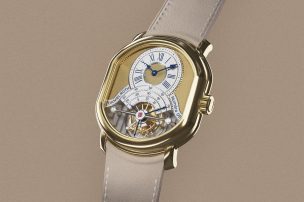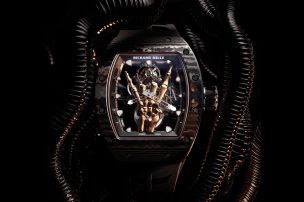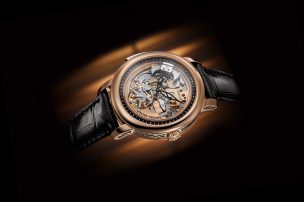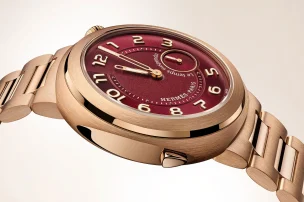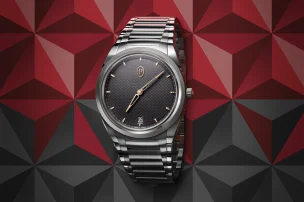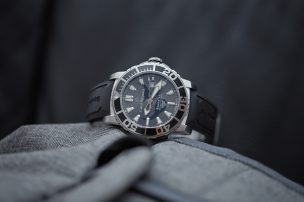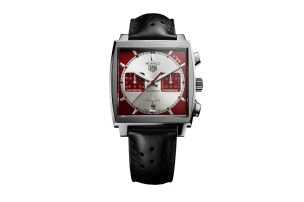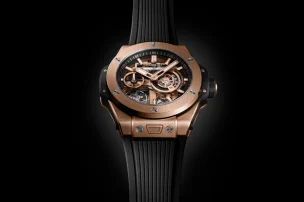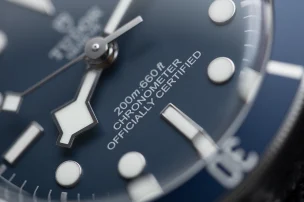
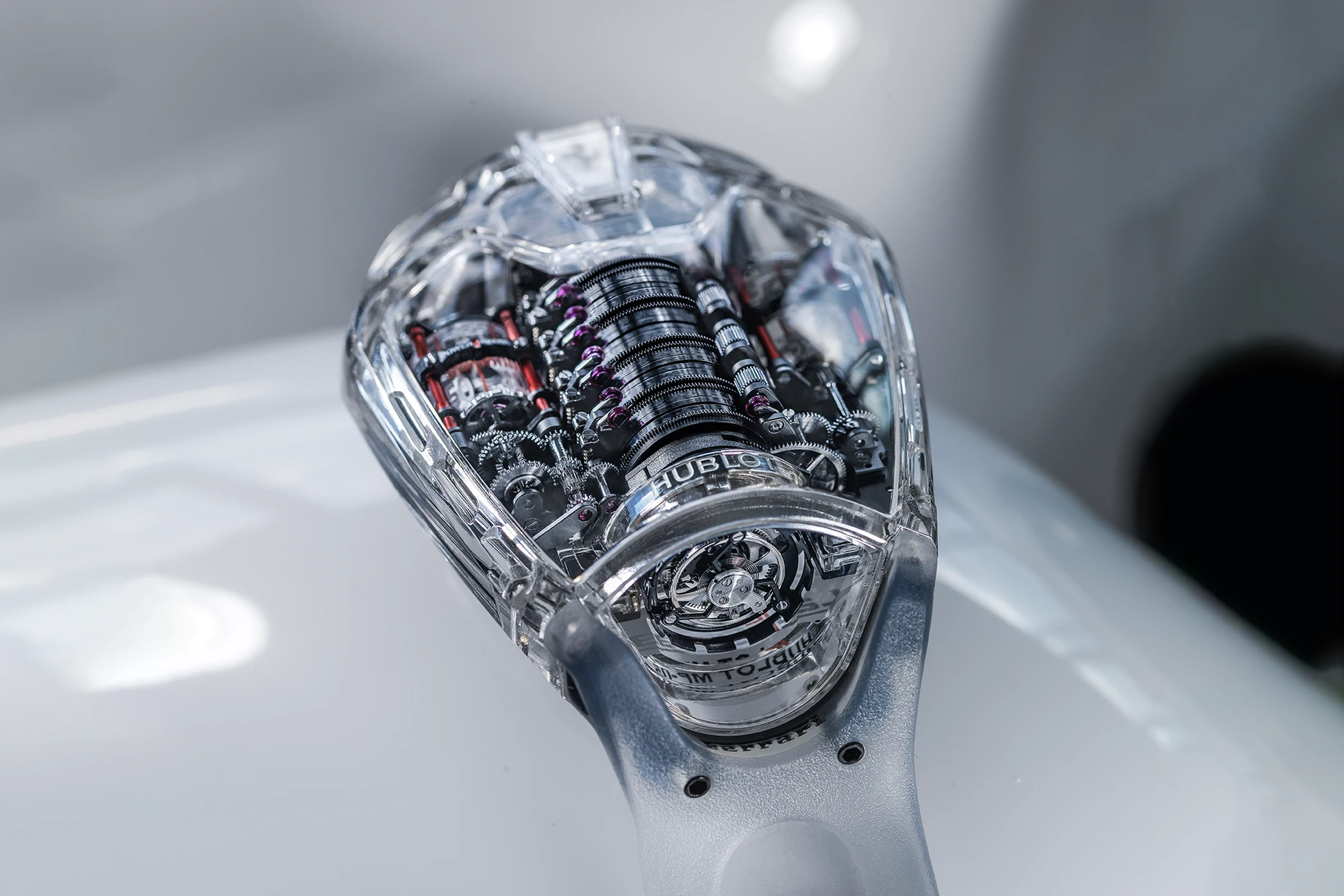
The Hublot Masterpiece Collection: Where Innovation Meets Extravagance
Launched in 2011, following the Big Bang, King Power, and Classic Fusion lines, Hublot’s Masterpiece (MP) collection marked the brand’s intensified focus on grand complications. Jean-Claude Biver, then CEO of Hublot, described the collection as the next step towards “more watchmaking, more expertise, more innovation.” From then on, 30 employees dedicated to grand complications brought this vision to life, resulting in timepieces like the MP-05 La Ferrari, with its impressive 50-day power reserve. The collection continues to be a driving force of innovation, with each watch showcasing a new technical advance. We’ve taken a closer look at this highly technical line and created a detailed overview of the most significant models and their outstanding complications.
HIGHLIGHTS 2011 – 2015
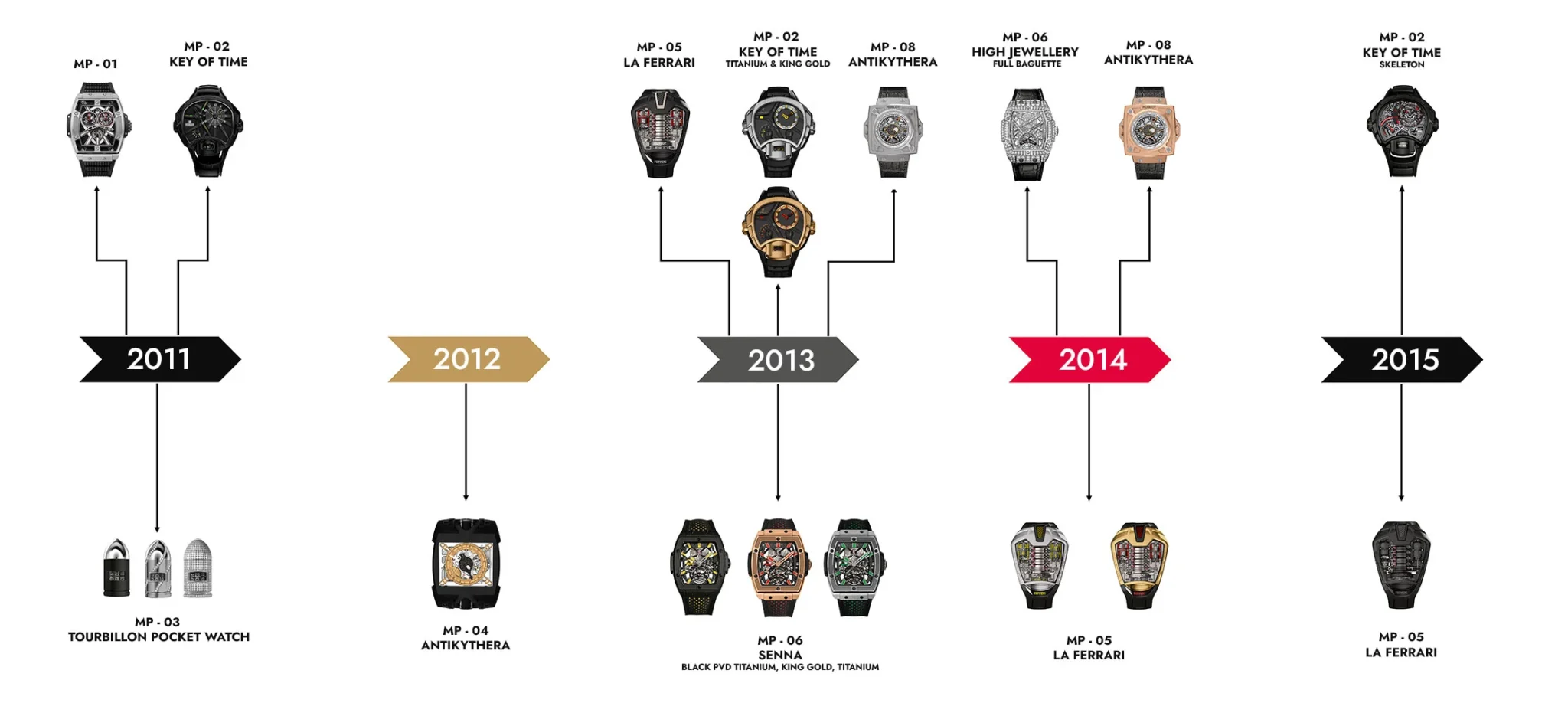
The MP-01 from 2011
The MP-01 was the first model of the Masterpiece collection, heralding a new era with its tonneau-shaped case and marking Hublot’s first significant departure from the brand’s signature round porthole form. This watch set new standards for the brand not only in design but also in construction, as it was equipped with an in-house movement that laid the foundation for further Masterpieces.
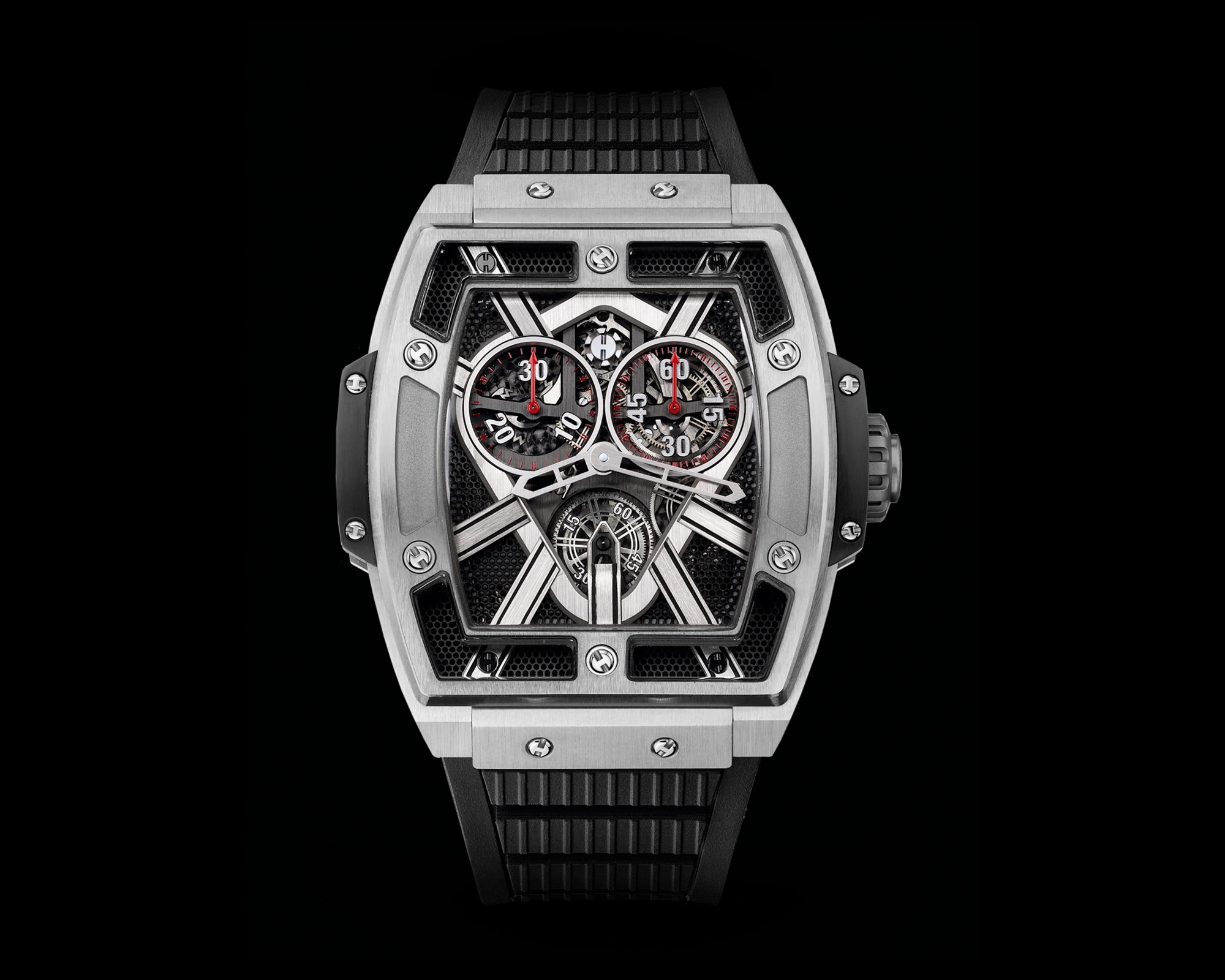
The first in-house movement
The MP-01 is powered by the HUB5100, a mono-pusher column-wheel chronograph calibre that was the first to be entirely developed and manufactured by Hublot’s High Complications department, while boasting a power reserve of 10 days. The movement follows the curves of the caseback, with many of the bridges and gears arranged at a slight angle.
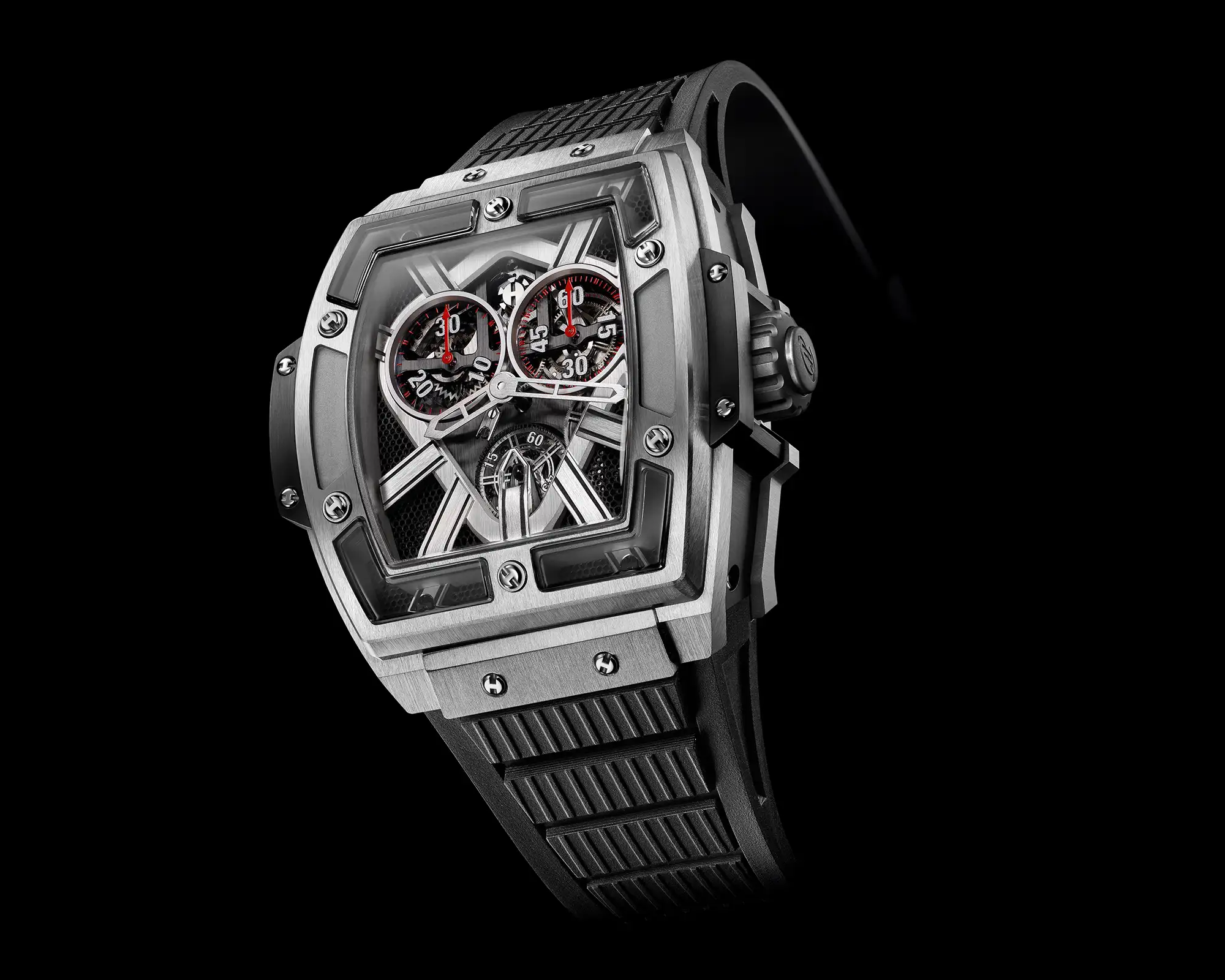
Aesthetically, the dial is skeletonised to reveal the mechanics of the chronograph. It features three counters: the chronograph second at 3 o’clock, the chronograph minute at 9 o’clock, and a small second counter at 6 o’clock.
The MP-02 Key of Time from 2011
In a world where an endless flow of information bombards us, we often experience a range of emotions within seconds. We shift from joy to sorrow or concern and back again, yet one constant remains, which today, in our fast-paced, fully digitalised world, will always be considered a true luxury: time. Time flies by, much like our emotions. With the MP-02, Hublot presented an almost philosophical approach to this phenomenon, aiming to give the wearer a certain degree of control over their time.
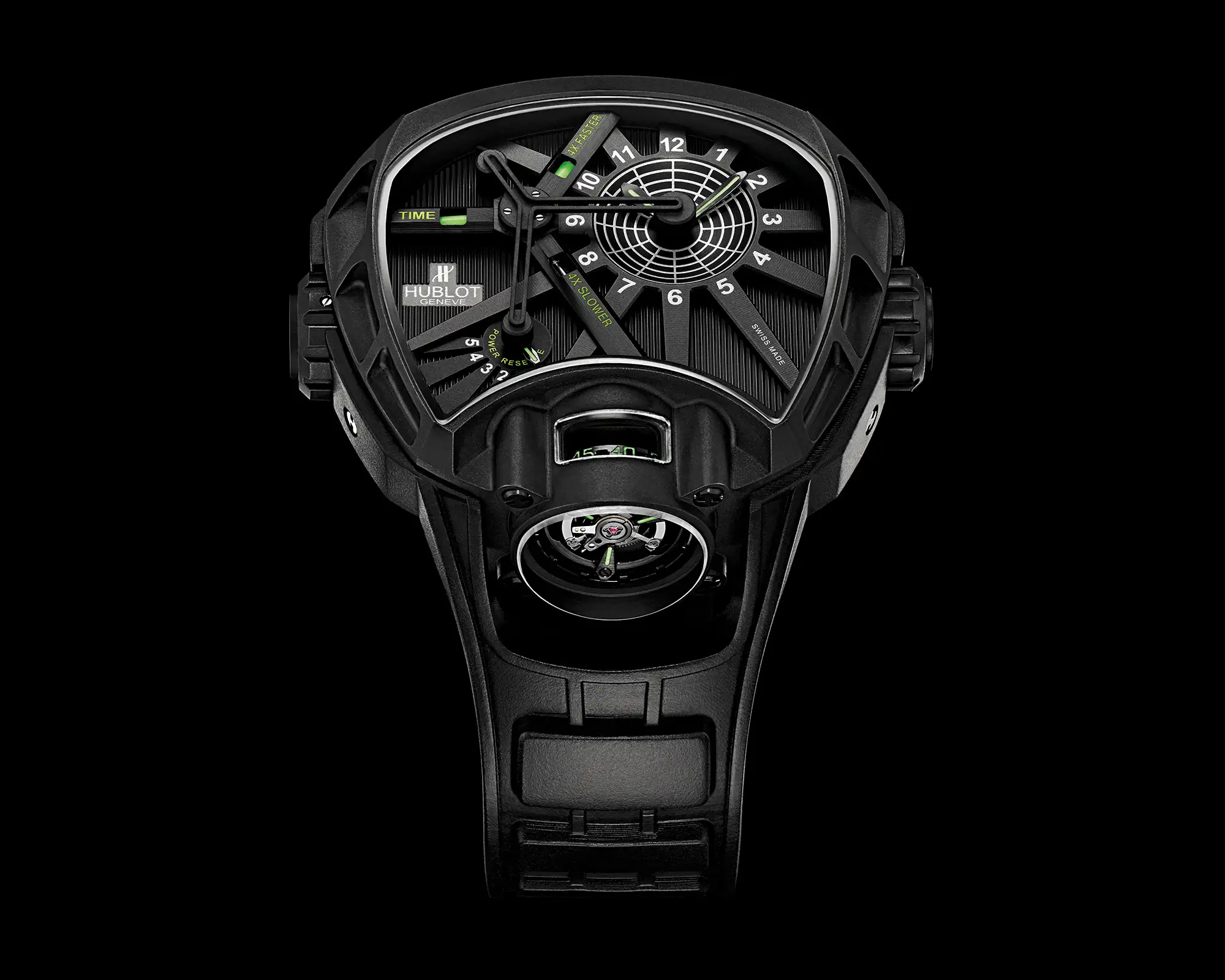
Three Ways to control time
By using a crown with three positions, the pace of time, specifically the speed at which the hours and minutes are displayed on the watch, can be altered.
In the first position, the hands move four times slower across the dial. On the MP-02 Key of Time, a conventional hour is displayed as a quarter of an hour.
In the second position, the hands move at normal speed across the dial.
The third position is for those who want time to pass as quickly as possible – four times faster, in fact. A conventional quarter of an hour now equals one hour.
The mechanics of the MP-02 Key of Time thus allow the wearer to play with time in a very real sense. Depending on the setting, the star-shaped hands position themselves accordingly, while in the default setting, they can always return to real-time thanks to a “mechanical memory.”
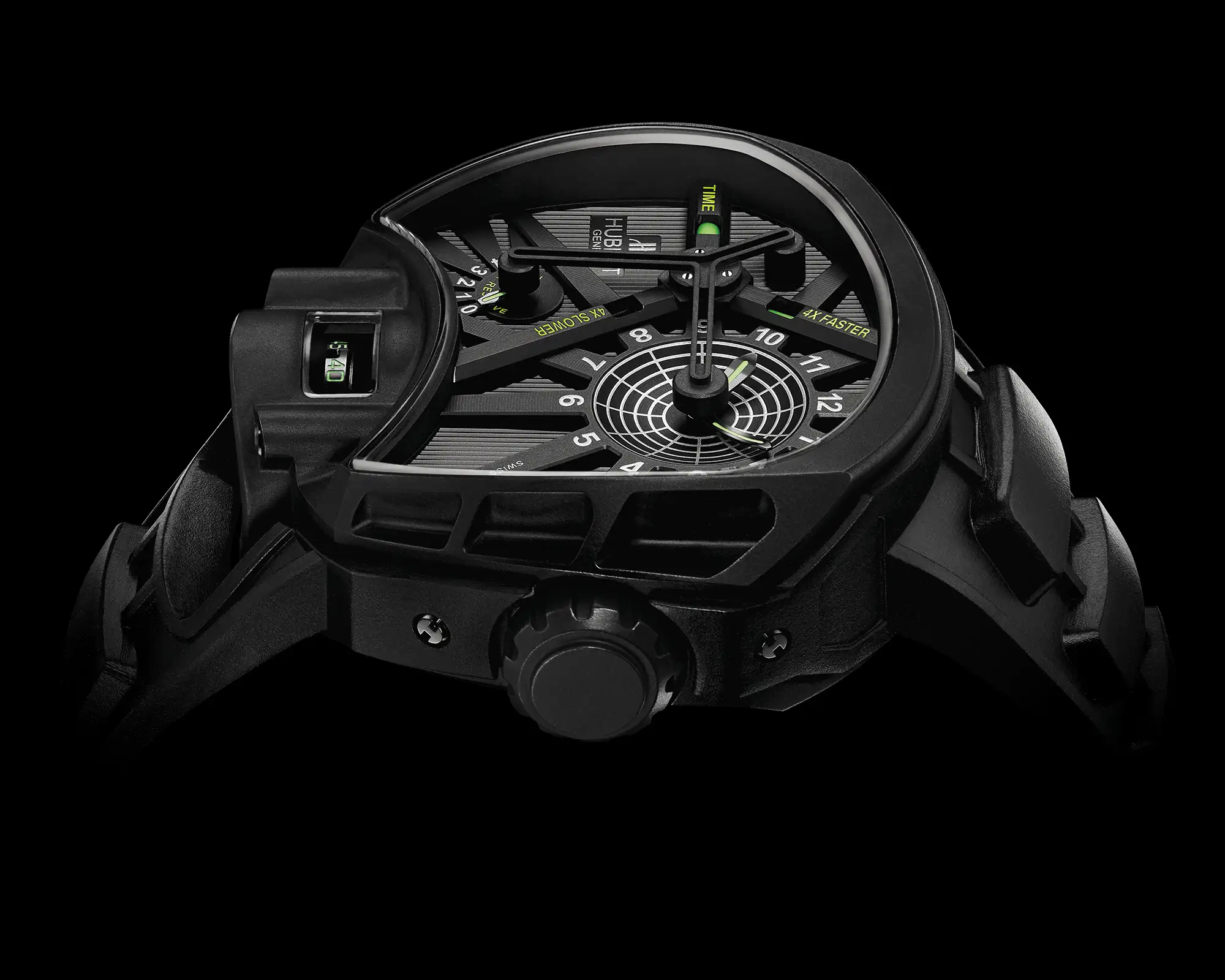
The Variations
While the original 2011 version of the MP-02, reference 902.ND.1140.RX, came in a black DLC-coated titanium case, subsequent years saw a series of variations featuring different materials. In 2013, a limited series of 50 pieces in an untreated titanium case (reference 902.NX.1179.RX) and a King Gold version limited to 30 pieces (reference 902.OX.1138.RX) were introduced.
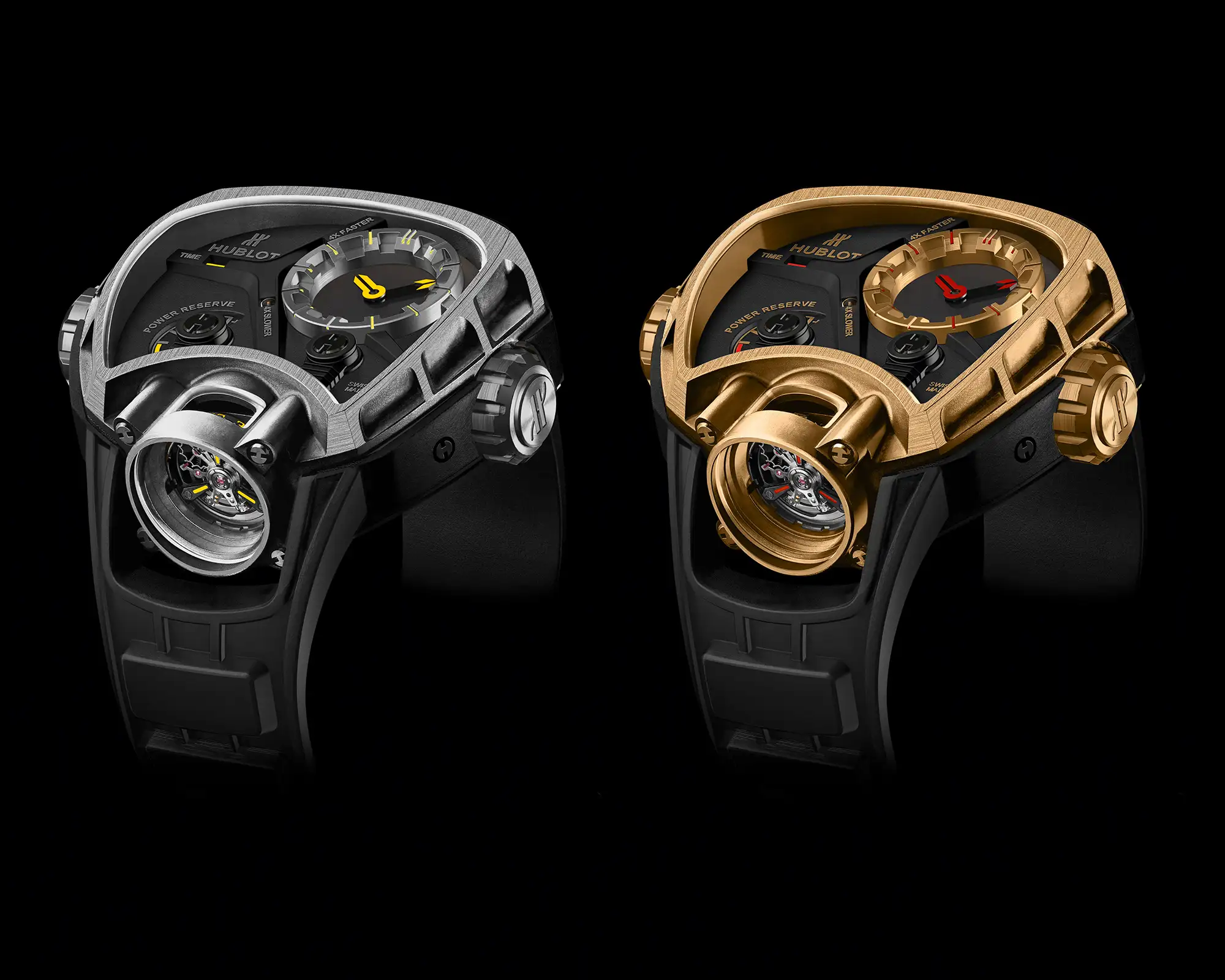
In 2015, Hublot unveiled the MP-12 Key of Time Skeleton, housed in a black PVD-coated titanium case (reference 912.ND.0123.RX) with a skeletonized HUB 9012 movement, limited to just 20 pieces.
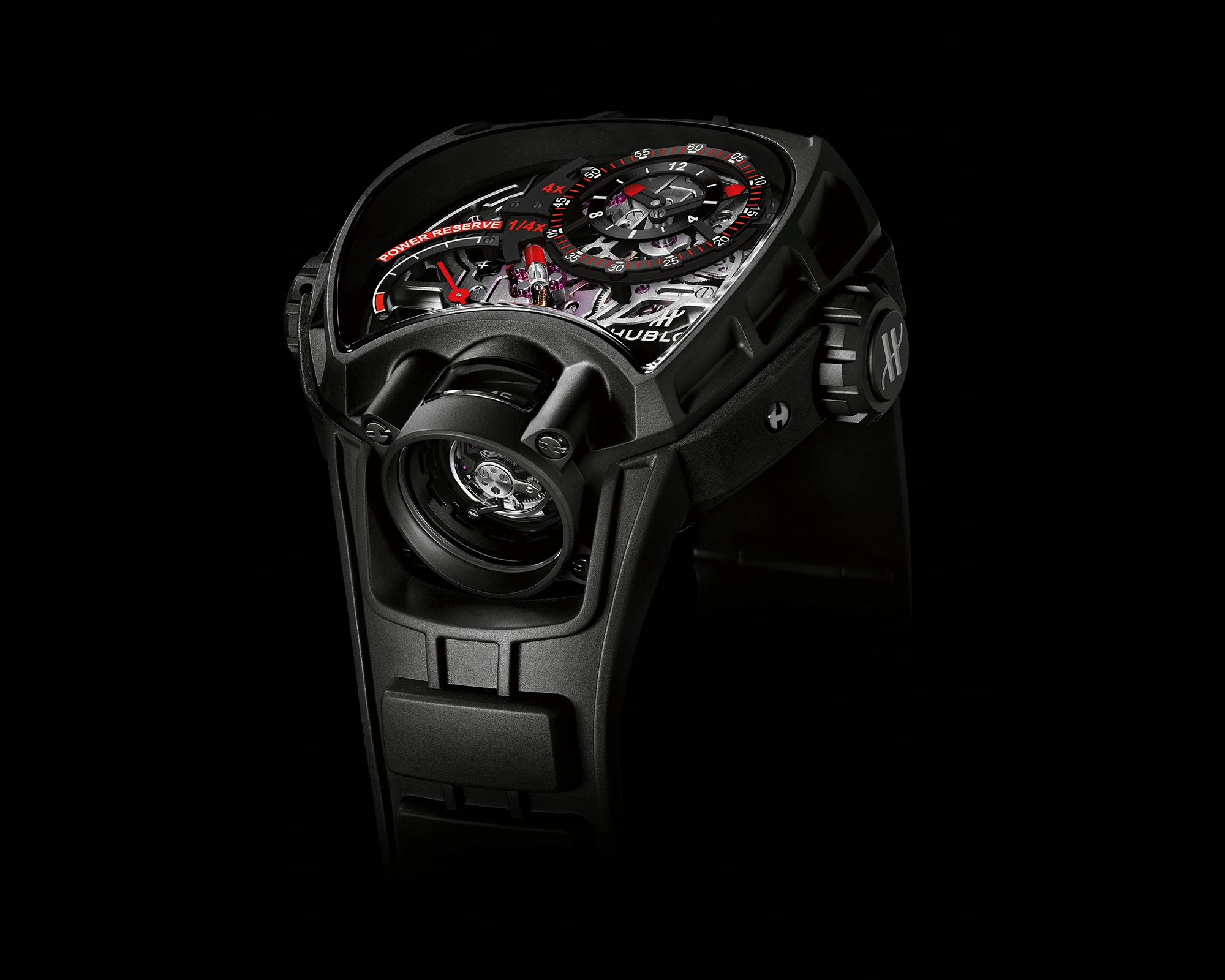
The MP-03 Pocket Watch from 2011
The third Masterpiece was a pocket watch in the shape of a bullet. Mathias Buttet, head of the High Complications department at Hublot, is said to have been inspired by the bullet shape during a trip to Mexico, where he saw locals wearing 9 mm bullets as necklaces, as they are considered lucky charms.
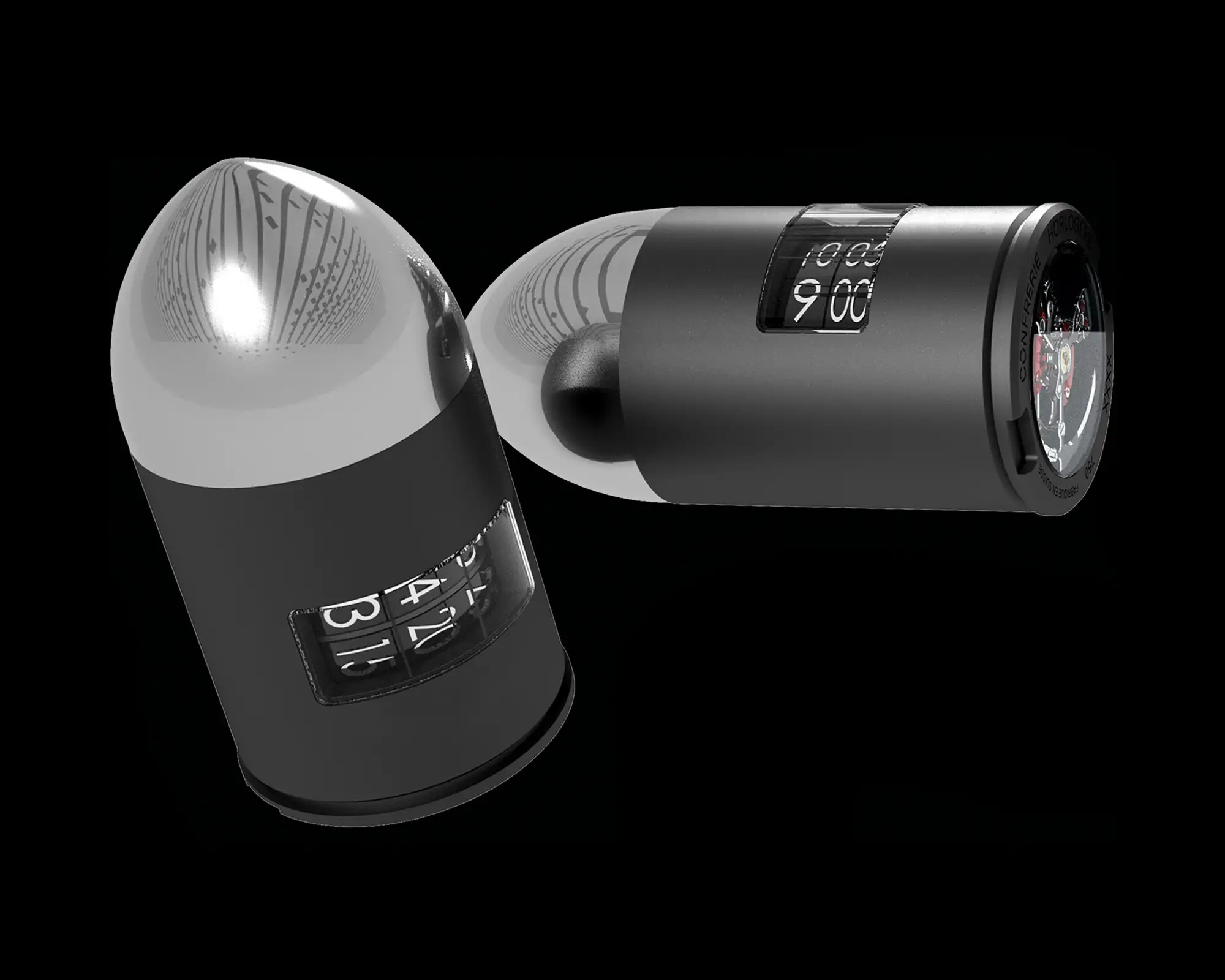
The movement, equipped with a horizontal tourbillon visible through the sapphire crystal caseback, displays the time via three rotating barrels visible through the case opening. The upper polished section serves as the crown, which must be turned to wind the watch and pulled out to set the time.
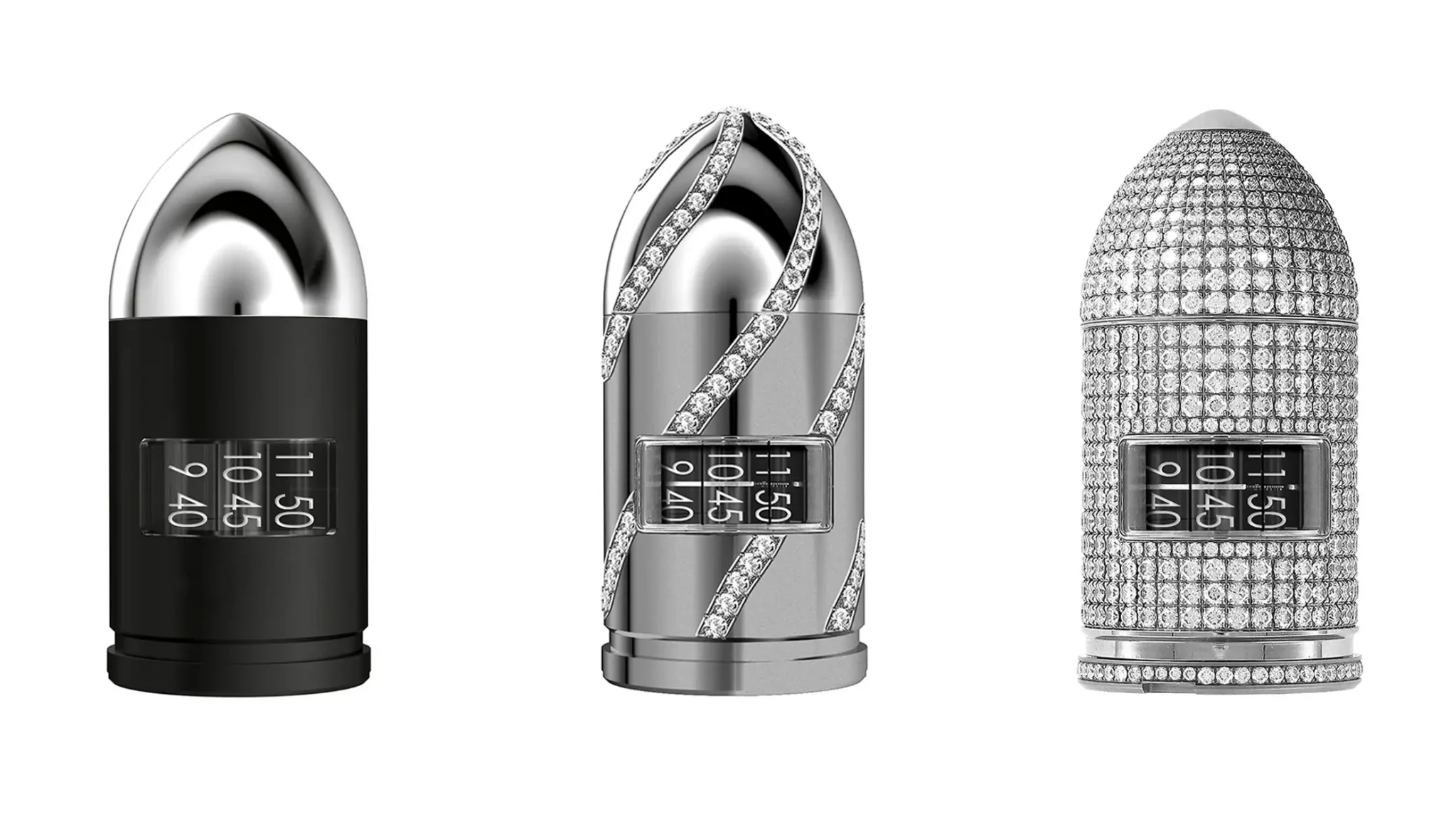
The MP-04 “Tribute to the Mechanism of Antikythera” from 2012
To understand the creation of this Masterpiece, we must look back to the spring of 1900 in the Aegean Sea. Off the coast of the small Greek island of Antikythera, some men were diving for sponges. However, one of them, Ilias Stadiatis, was to discover something far more significant: an ancient shipwreck on the seabed. The Roman ship, which was one of the largest ancient ships ever found at over 50 metres in length, is believed to have sunk between 70 and 60 B.C. For a year, the sponge divers, soon supported by the Greek Navy, brought numerous artefacts ashore, including the Antikythera Youth, a 1.94-metre tall bronze statue.
Amongst these treasures was a small lump of corroded metal with remnants of a wooden box, initially overlooked. But on 20 May 1902, when Spyridon Stais visited the museum’s storeroom, he was the first to recognise that the now-deteriorated bronze lump with inventory number X 15087 must be the remains of a complex precision instrument.
Initially, it was thought to be an astrolabe (an astronomical instrument that maps the night sky), while later it was assumed to be some sort of calculating machine. However, due to technological limitations, nothing more could be deduced from the metal lump, and it fell into obscurity. It wasn’t until the 1950s that British science historian Derek de Solla Price began to study the 82 fragments intensively. He had them X-rayed and gamma-rayed, uncovering groundbreaking insights: hidden gears, inscriptions, and remains of mechanisms became visible. Price described his discovery as an “ancient computer” and ensured that the mechanism gained worldwide recognition.
“Like Finding an Atomic Bomb in a Pyramid”
The Antikythera Mechanism, which Price described as finding “like an atomic bomb in a pyramid”, dates back to the late 2nd century B.C. and is by far the most sophisticated device known from antiquity. The apparatus was once a complex mechanical “computer” that calculated the cycles of the solar system and astronomical phenomena. It had the ability to display the movements of celestial bodies visible from Earth. For example, it featured an eclipse calendar to indicate past and future solar and lunar eclipses.
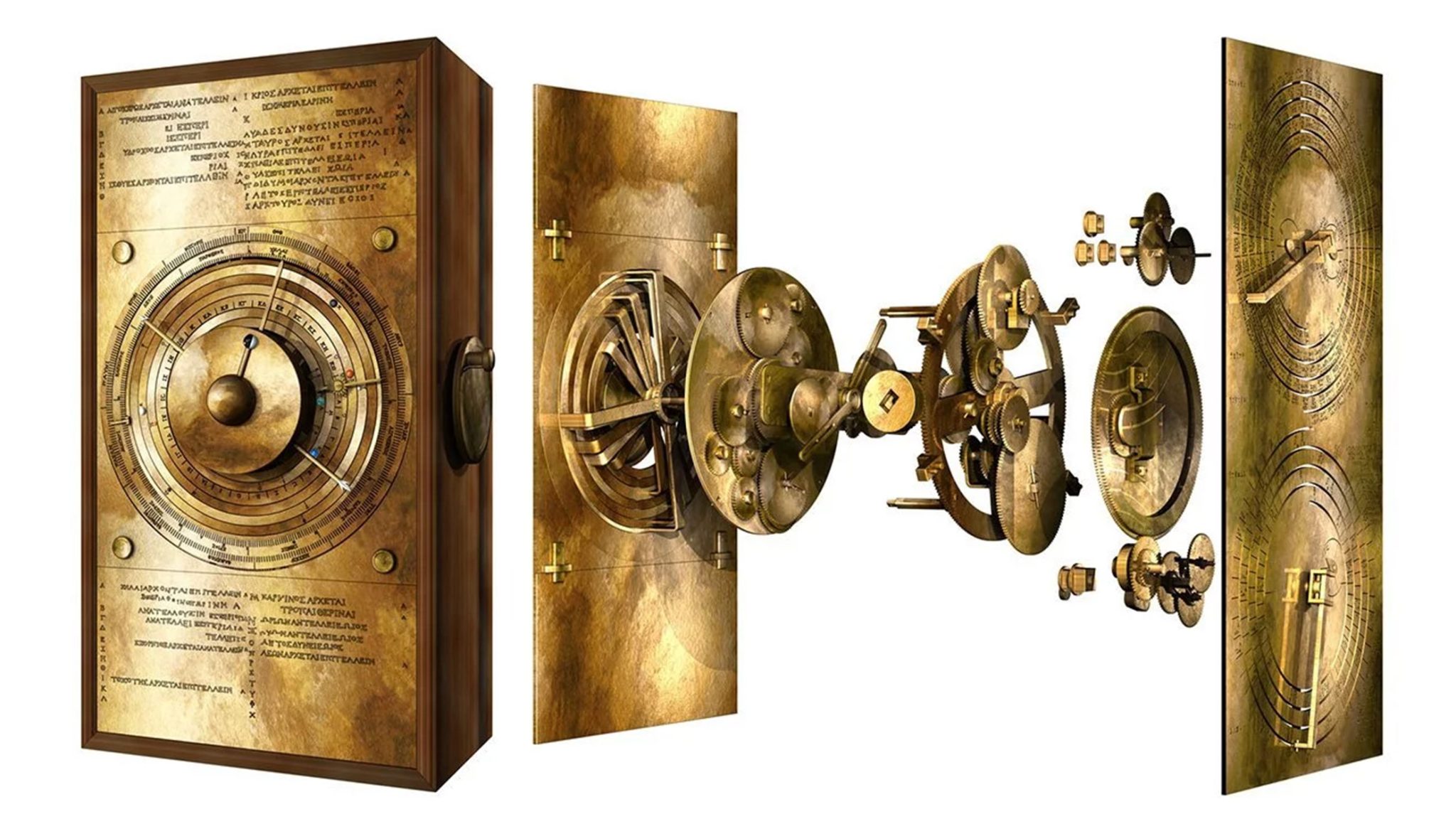
What’s remarkable is that the mechanism represented the entire accumulated astronomical knowledge of the ancient Greeks and Babylonians, and, in fact, humanity took more than a millennium and a half to reach a similar level of technology.
The ‘Tribute to the Antikythera Mechanism’
On 5 April 2012, all the original remnants of the ship, the treasure, and the fragments of the Antikythera Mechanism were brought together for the first time at the prestigious National Archaeological Museum in an exhibition attended by the Greek Minister of Culture. This event garnered significant attention within the international archaeological and scientific community. Among the objects on display was the watch ‘Tribute to the Antikythera Mechanism’, a complex timepiece developed by Hublot as a tribute to the first astronomical calculation instrument: the MP-04 Antikythera. It was the first time a watch manufacture had gained entry to an archaeological museum.
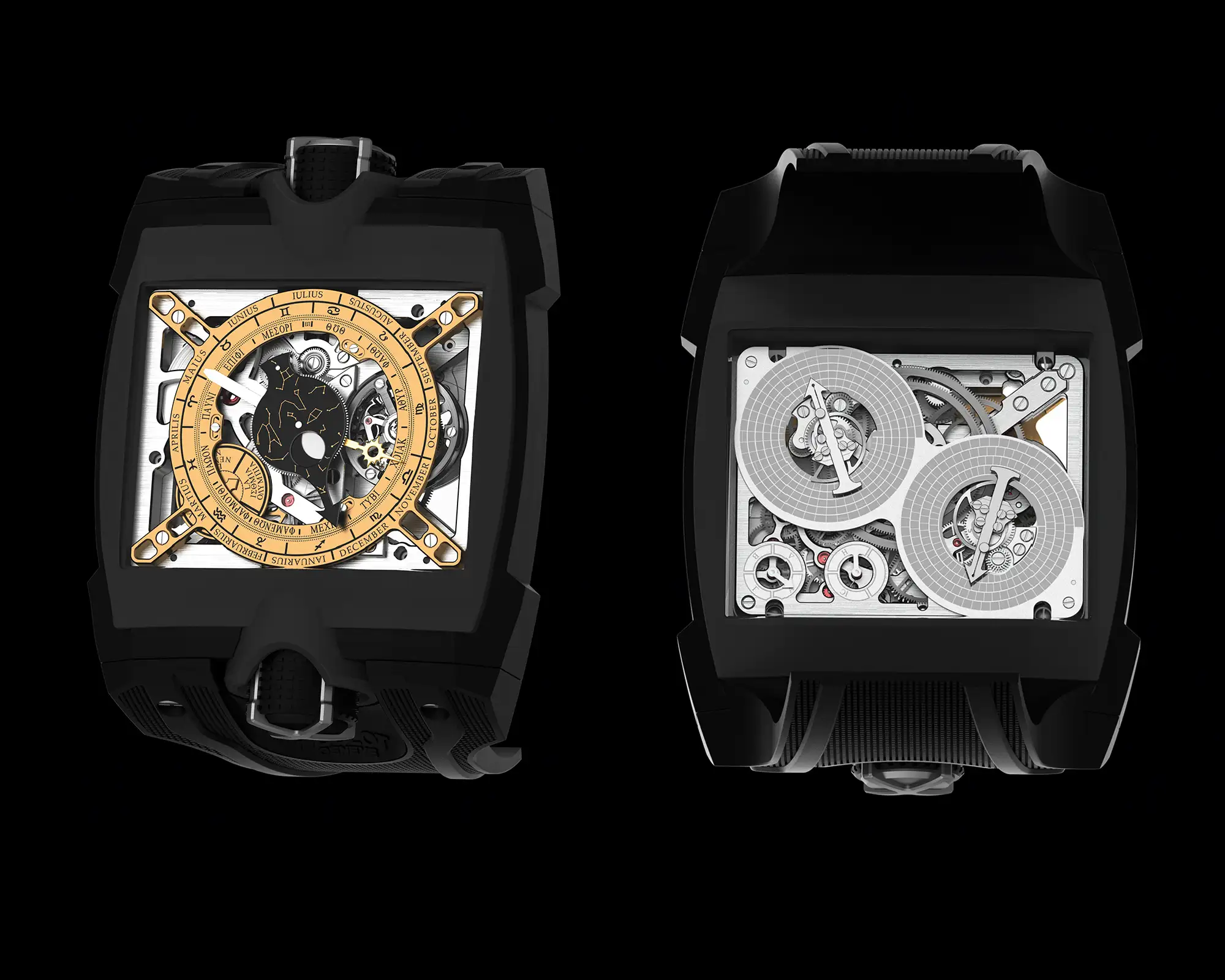
On the initiative of Jean-Claude Biver, only four examples were produced: the first was given to the Athens museum, where it took its place alongside the original fragments of the Antikythera Mechanism. The second was auctioned, with the proceeds going to the Archaeological Museum in Athens, the third was displayed at the Musée des Arts et Métiers in Paris, and the fourth is kept by Hublot in the museum of its manufacture.
The MP-05 La Ferrari from 2013
The MP-05 was the result of the creative vision of Ferrari’s chief designer, Flavio Manzoni, who sketched the basis for the watch’s design. When it debuted in 2013, it was designed to evoke the experience of looking under the bonnet of the LaFerrari. Indeed, a glance through the sapphire crystal reveals that the movement, with its vertically aligned tourbillon and 11 barrels, not only set a world record at the time with its impressive 50-day power reserve but also bore a remarkable resemblance to an engine.
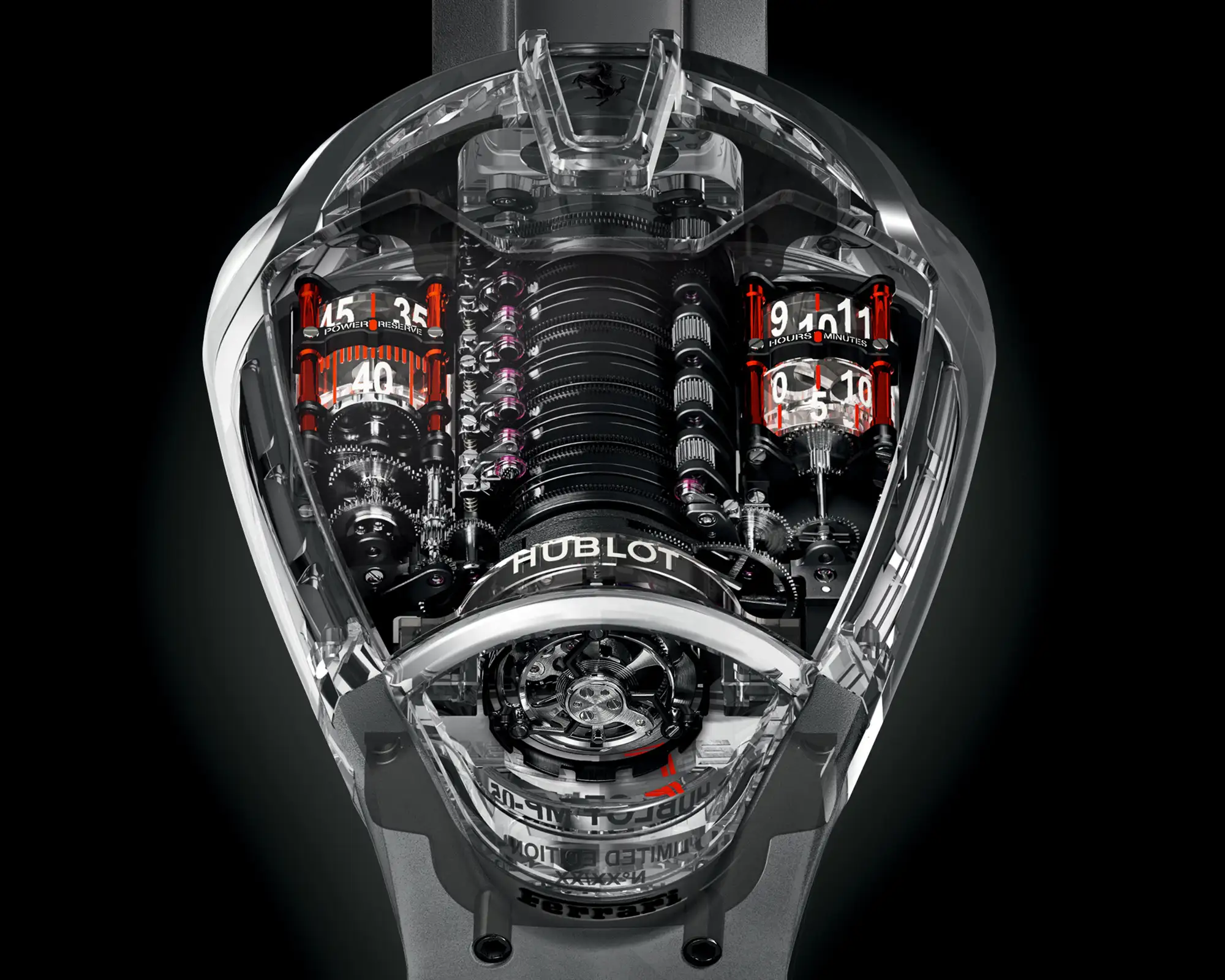
Although legibility was not the primary focus, it is still well highlighted by cylindrical displays. On the right side are two barrels, with the upper one indicating the hours and the lower one the minutes. The seconds are displayed on the tourbillon cage, which can be viewed at the bottom of the movement through the sapphire crystal. The power reserve is also displayed via barrels on the left side of the watch. Overall, these elements, with their 637 individual parts, provide the highest number of components ever used in a Hublot movement to ensure a power reserve of 1,200 hours.
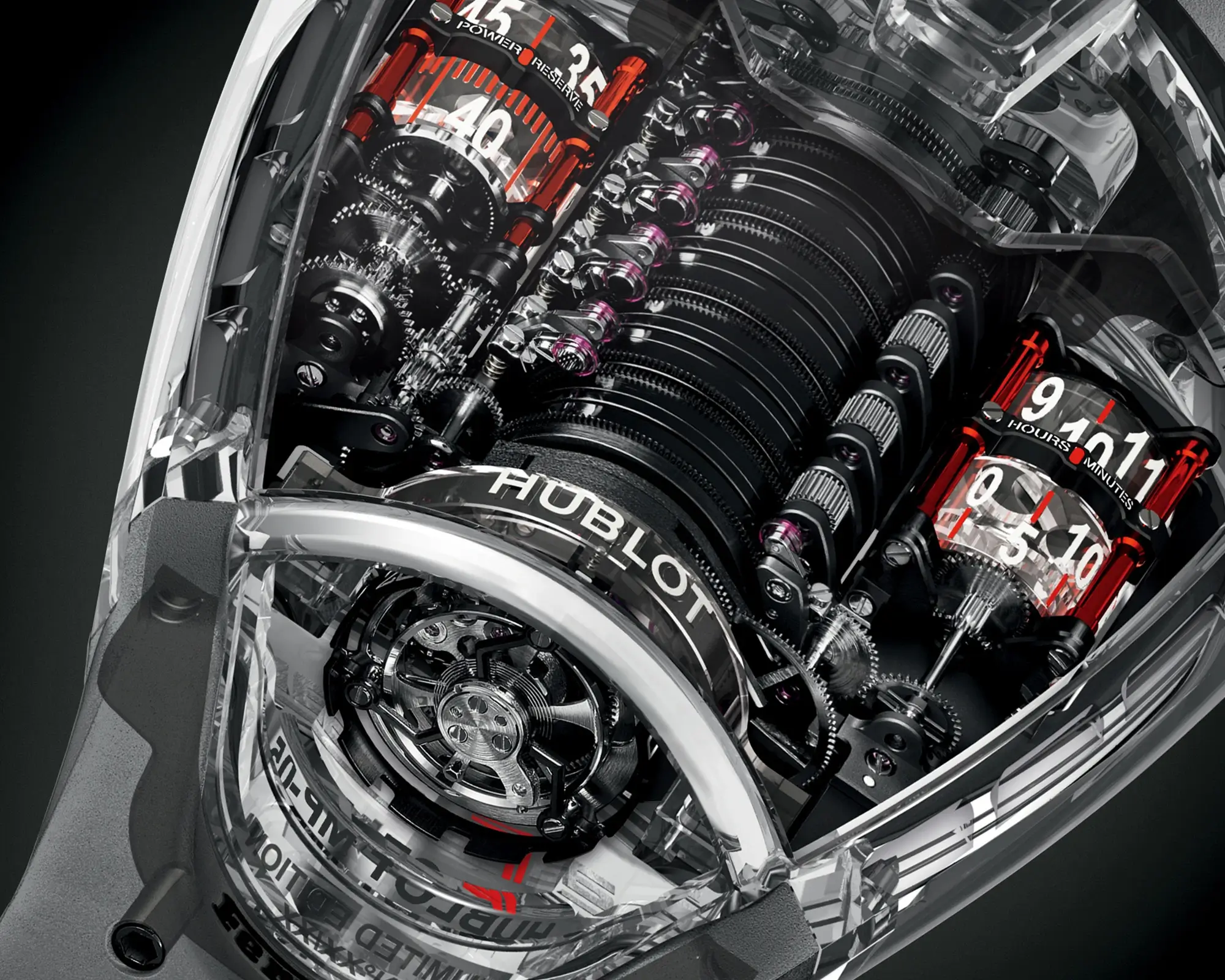
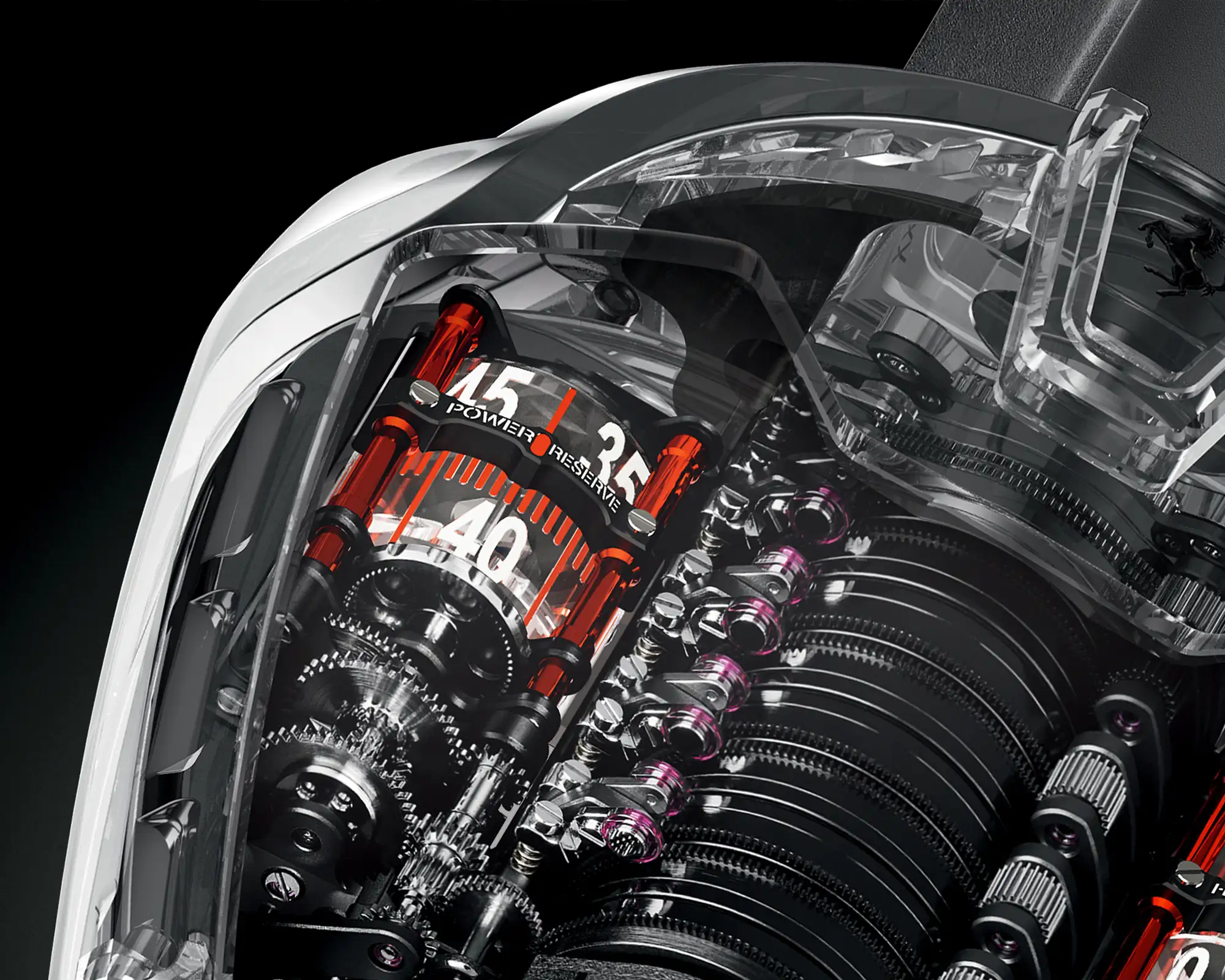
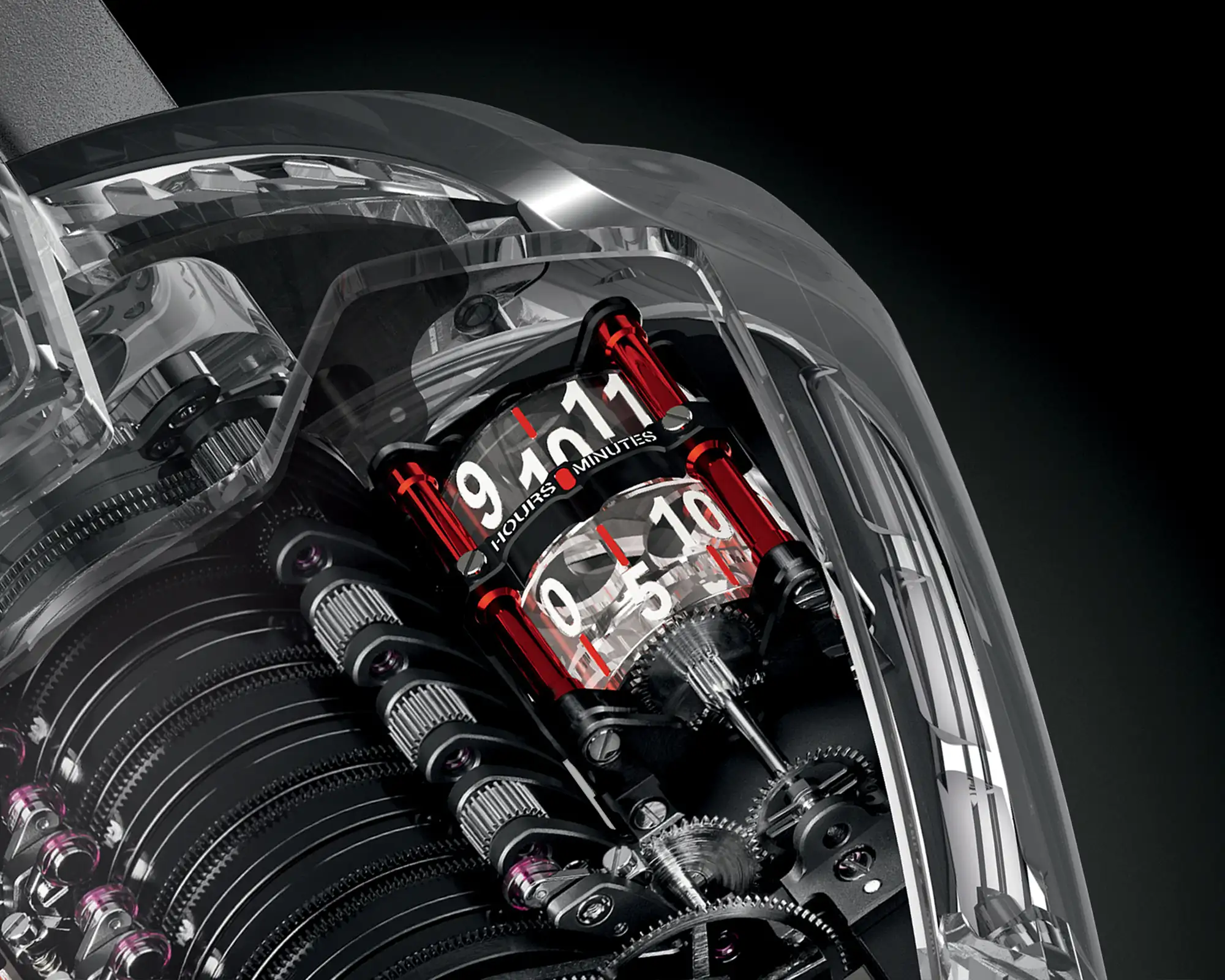
600 hours of work for one case
Over the years, the MP-05 has been released in a variety of different case variations. The original version was introduced with a black-coated titanium case (reference 905.ND.0001.RX) in a limited edition of 50 pieces. In 2014, two new versions followed, including one with a solid block of yellow gold case (reference 905.VX.0001.RX) and another made from untreated titanium (reference 905.NX.0001.RX), which has since become a favourite among collectors.
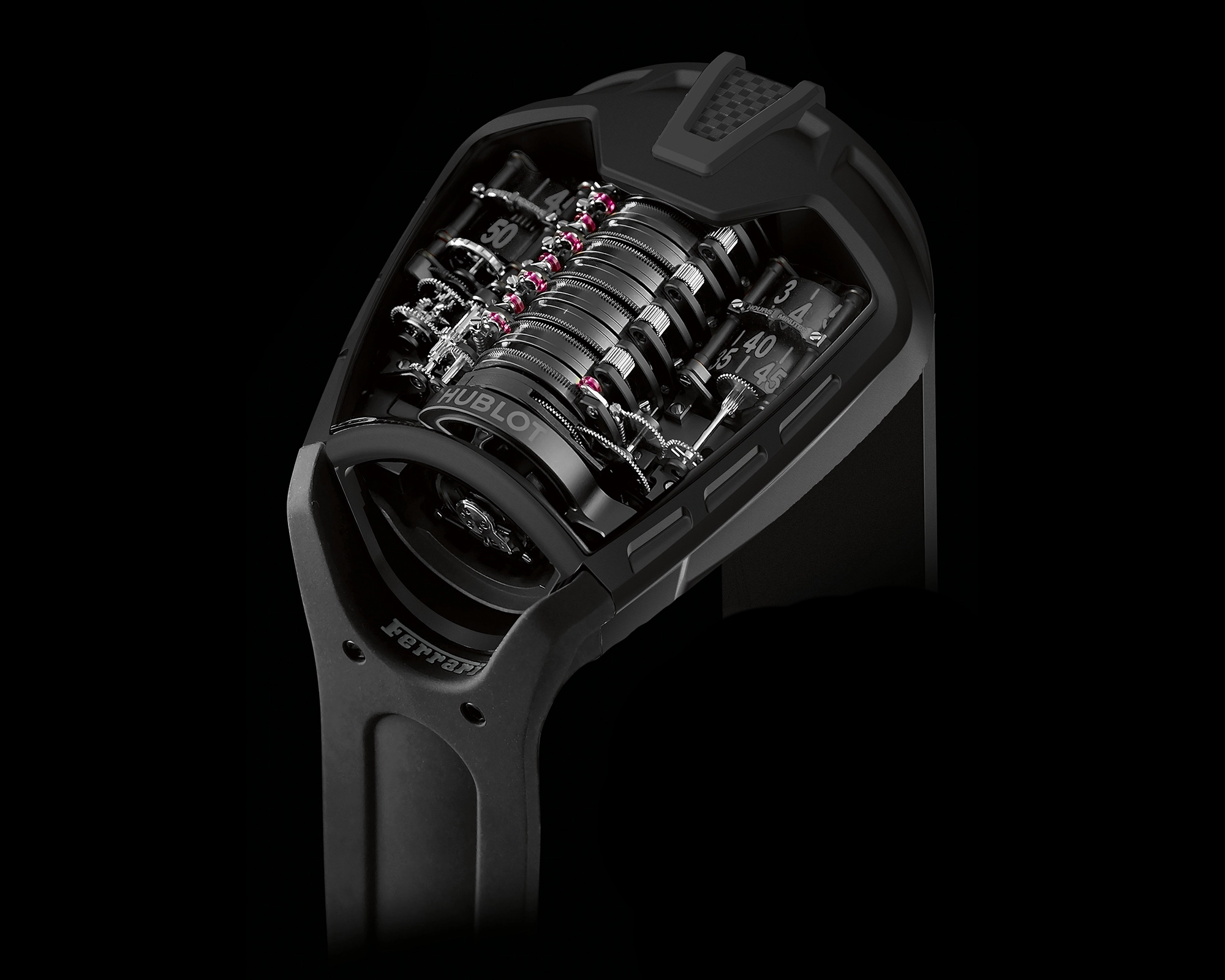
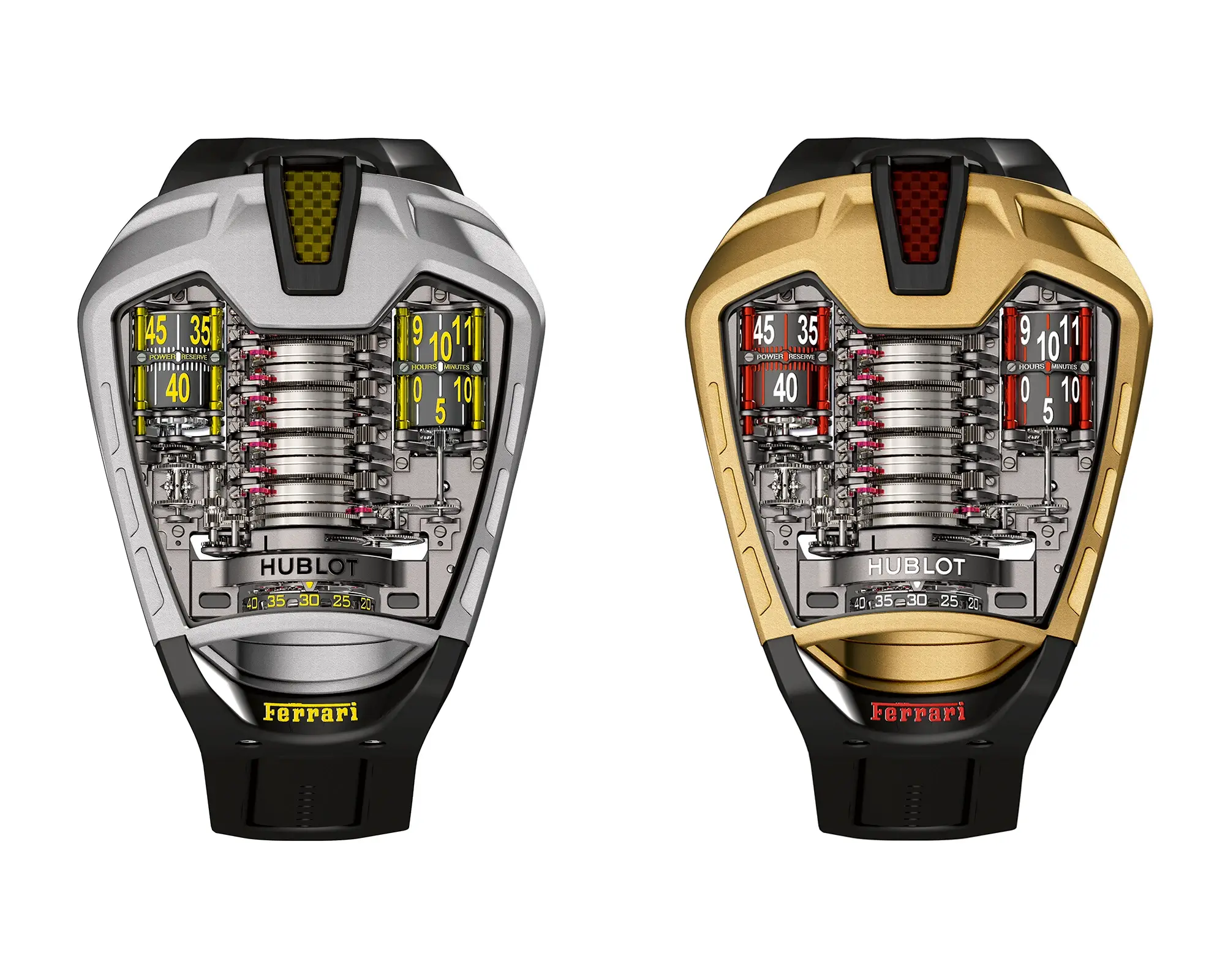
In 2016, Hublot presented another highlight at Baselworld: the brand unveiled an MP-05 LaFerrari with a sapphire crystal case (reference 905.JX.0001.RT), composed of seven individual parts. According to Hublot, each of these cases required around 600 hours of work and yet weighed only 53.5 grams.
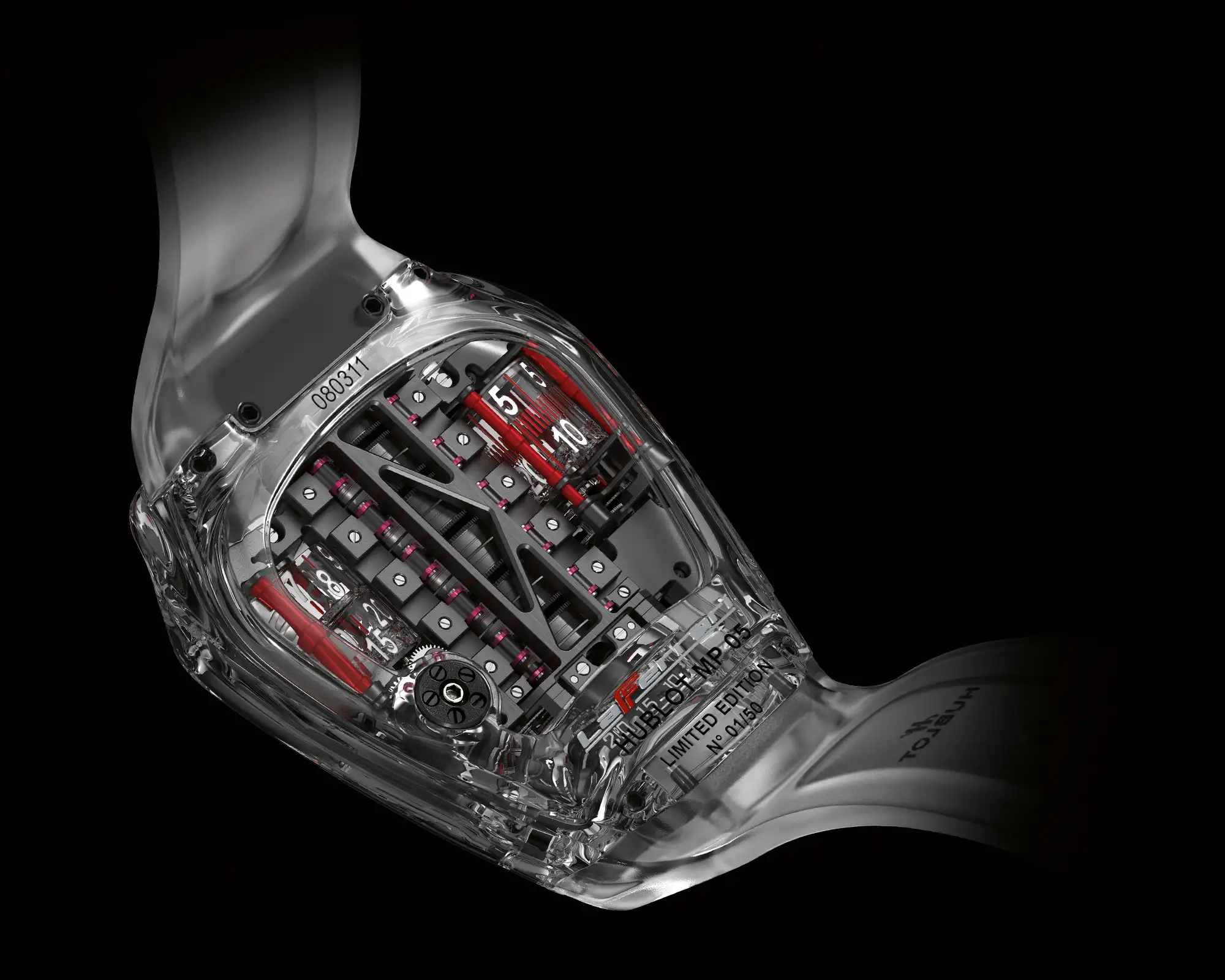
The MP-06 from 2013
In 2013, Hublot introduced the MP-06, the fourth watch in honour of Ayrton Senna. This tribute joined a series of timepieces dedicated to Senna, starting with the first Big Bang Senna unveiled in 2007, followed by the Big Bang Foudroyante Senna, which premiered in Tokyo in 2009, and the King Power Ayrton Senna, revealed during the São Paulo Grand Prix in 2010 to mark his 50th birthday. The fourth instalment celebrated Senna’s remarkable 41 race victories and three world championship titles with three variations, each produced in a numbered edition of 41 pieces. Buyers could choose between versions made from King Gold, titanium, or black PVD-coated titanium.
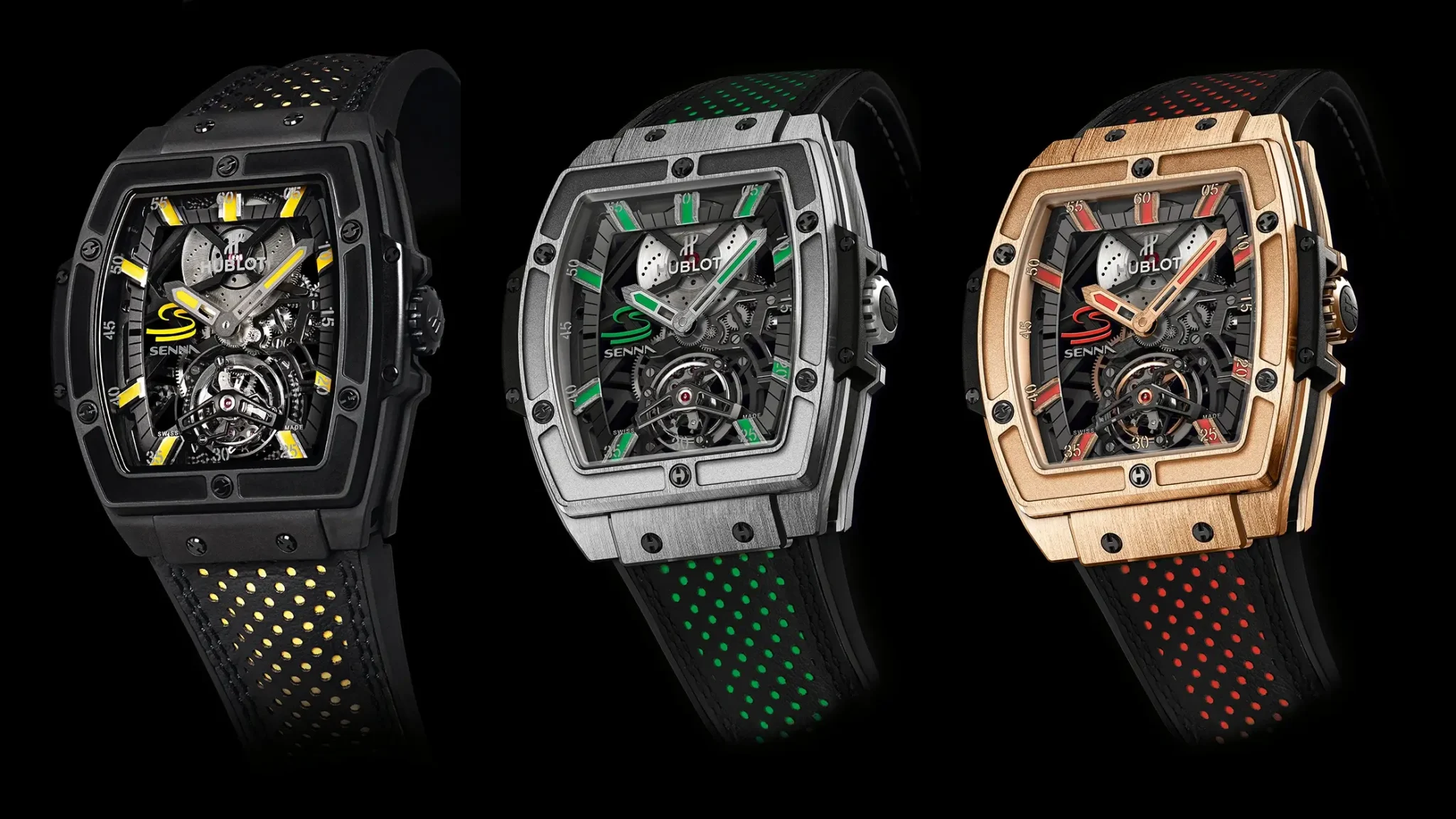
The skeleton dial
The skeleton dial, made from sapphire crystal, offers an unobstructed view of the precise tourbillon movement, composed of 155 individual parts, with a power reserve of five days. The Senna logo, rendered in yellow, green, or red depending on the version, is positioned at 9 o’clock on the sapphire dial. The watch also comes in a specially designed Hublot box, which includes a detailed miniature of Ayrton Senna’s helmets from 1988, 1989, and 1991.
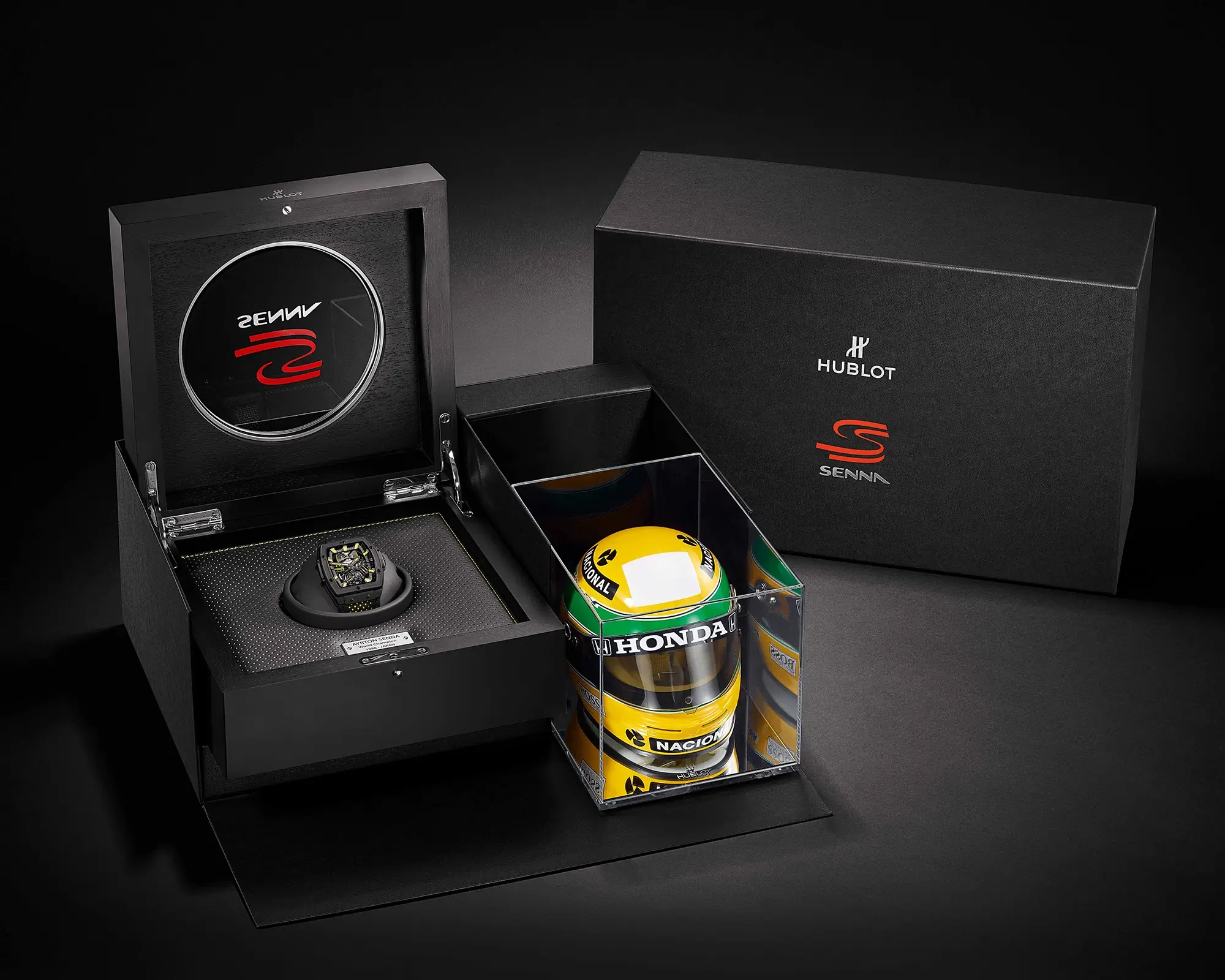
Hublot Masterpiece Collection: the MP-08 Antikythera SunMoon from 2013
While the MP-04 Antikythera from 2012 was never made available to the public, Hublot developed the “Antikythera SunMoon” for Baselworld 2013, a special series of 20 pieces and an evolution of the MP-04. The watch was a homage to the work of antiquity, replicating the original mechanism in a miniaturised and simplified form.
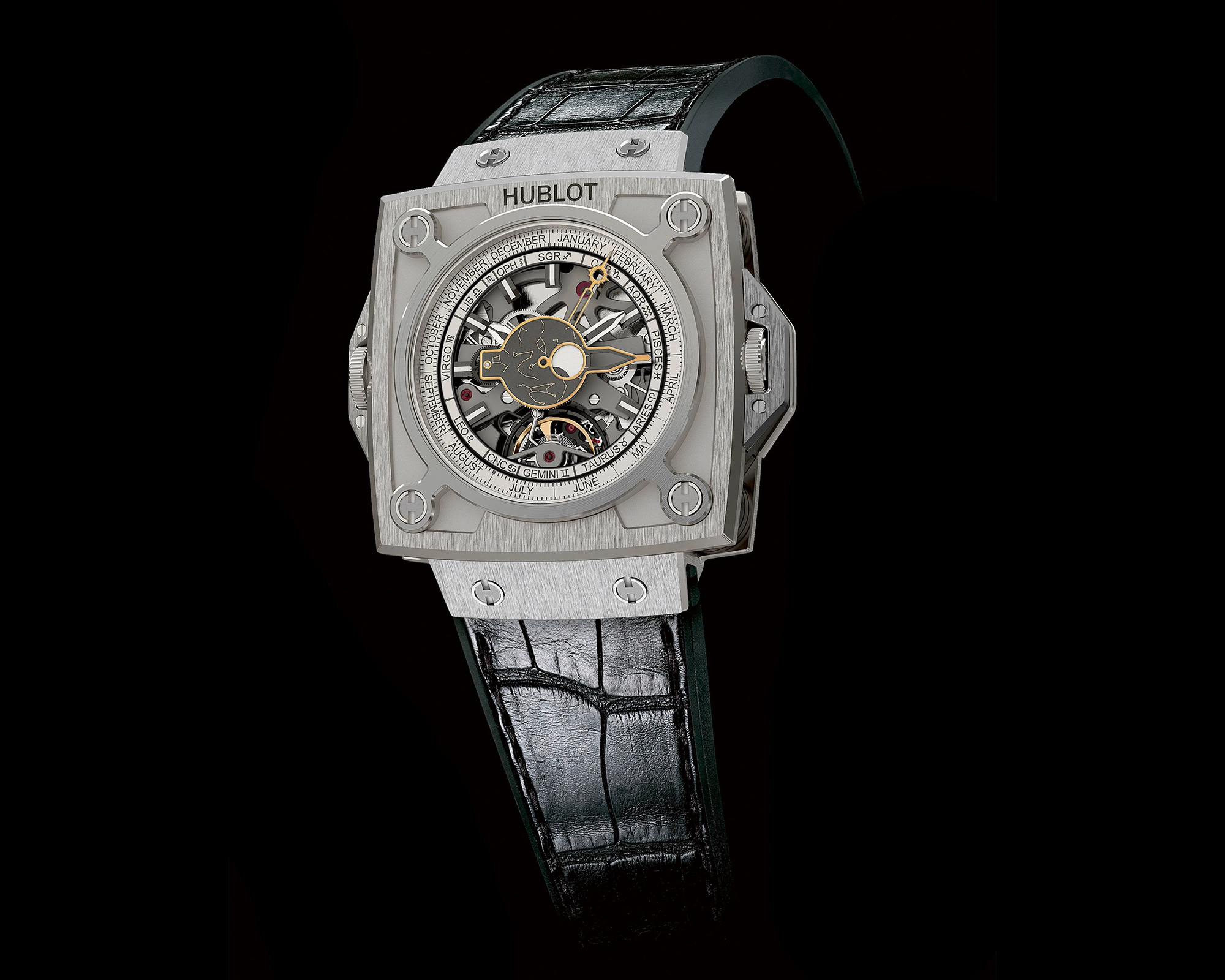
The Antikythera SunMoon features a movement with 295 components, an 80-hour power reserve, and seven complications (as opposed to the 495 components and 14 functions of the Hublot mechanism displayed in the Athens Museum). It also has indicators for the moon and sun, all of which are displayed on the dial.
Much more than a simple moon phase: The functionality of the Antikythera SunMoon
The Antikythera SunMoon is considered a solar and lunar calendar that shows the sidereal position of the sun and moon. This means that the wearer not only knows the time (hours and minutes) but also the exact position of the moon for a specific day, its shape in the sky, the name of the constellation behind the moon, and how long it will take the moon to pass through a constellation. Additionally, the watch reveals the constellation behind the sun for the same day and how long it will take the sun to pass through a constellation. This is complemented by a flying tourbillon that makes one rotation per minute to indicate the seconds, along with traditional hour and minute hands in the centre of the movement on the dial side.
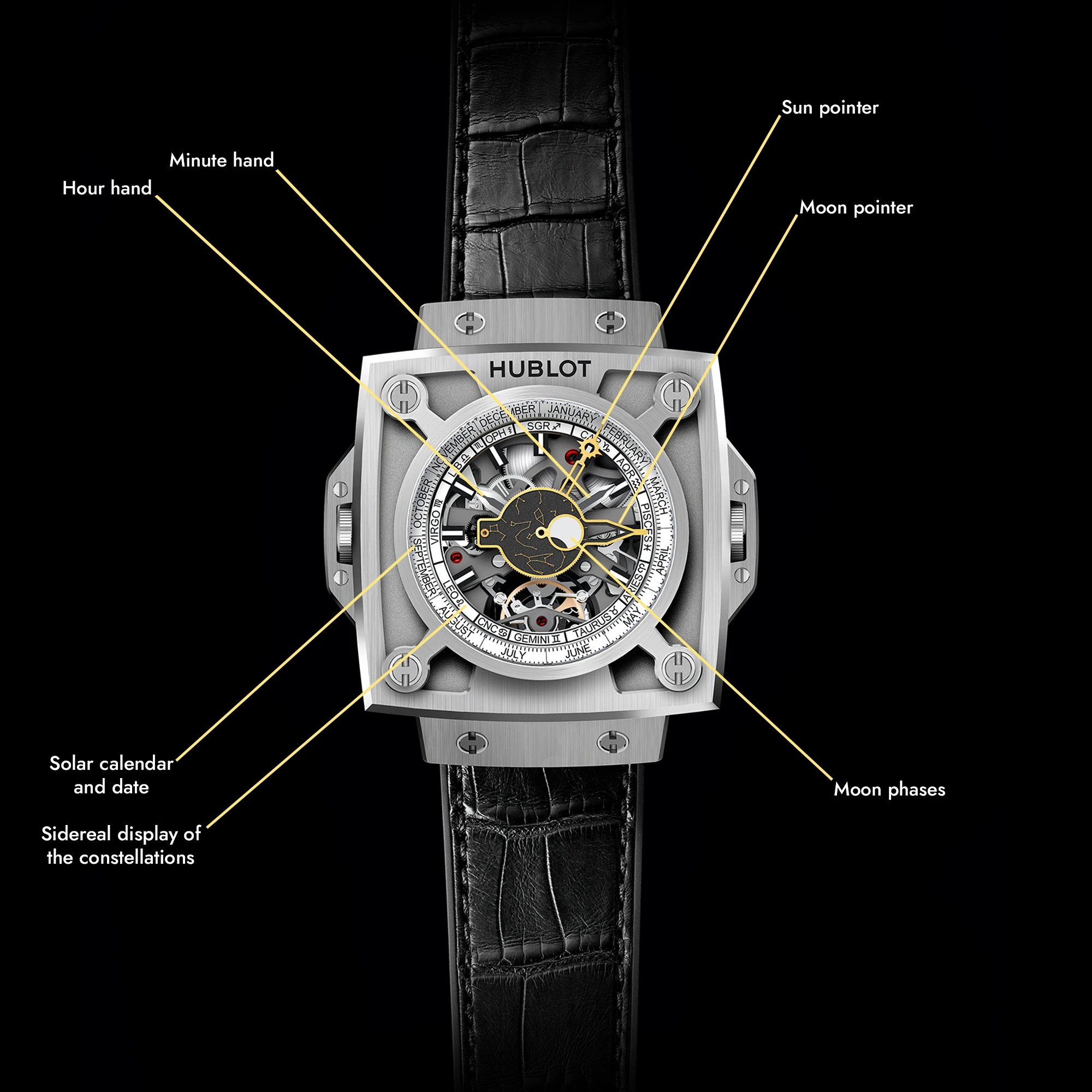
HIGHLIGHTS 2016 – 2020
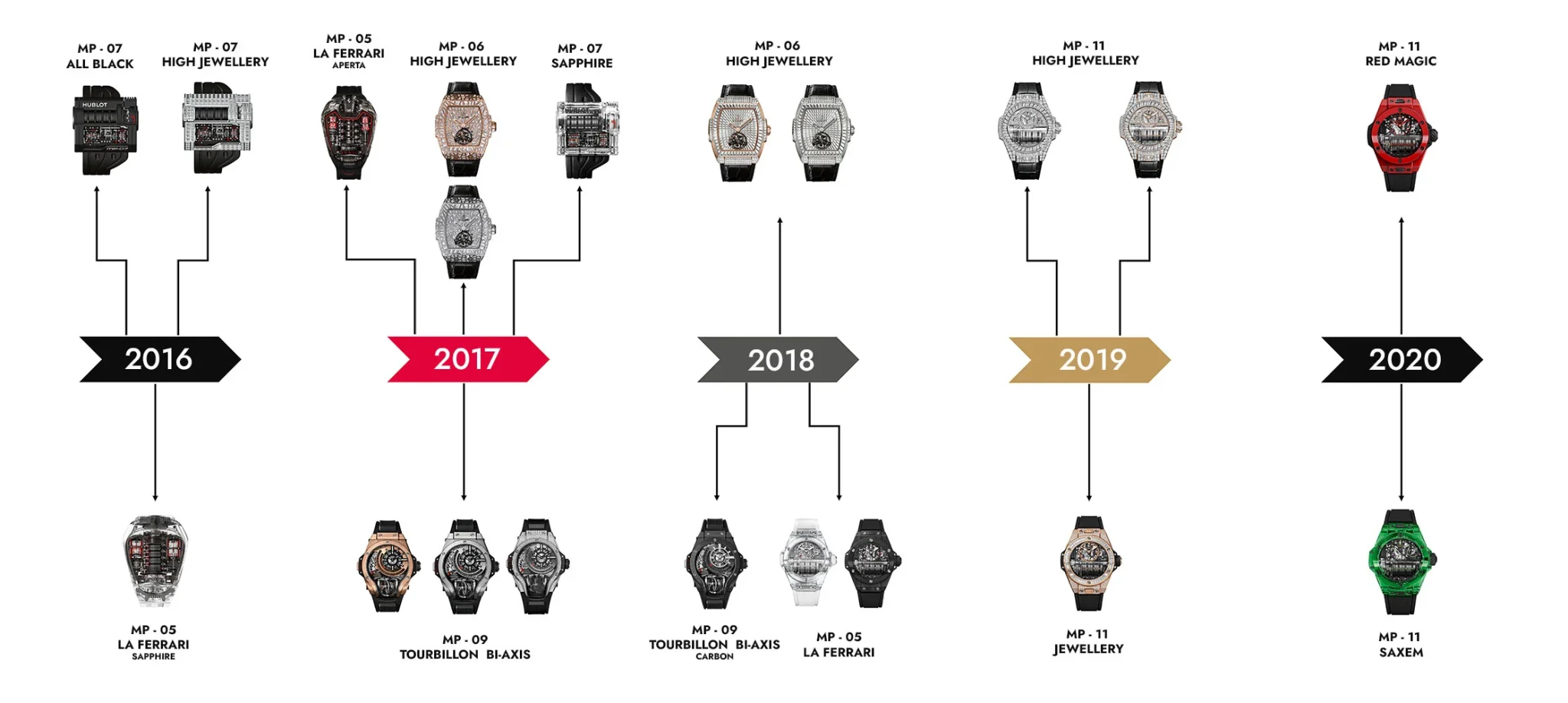
The MP-07 from 2016
With its construction, the MP-07 continued what the MP-05 La Ferrari had already established. While the core idea – ensuring the longest possible power reserve – remained the same, the two watches differed entirely in their inner workings and outer appearance. However, the most significant parallel to its predecessor was the movement’s construction, driven by a series of interconnected barrels and featuring cylinders to display the time.
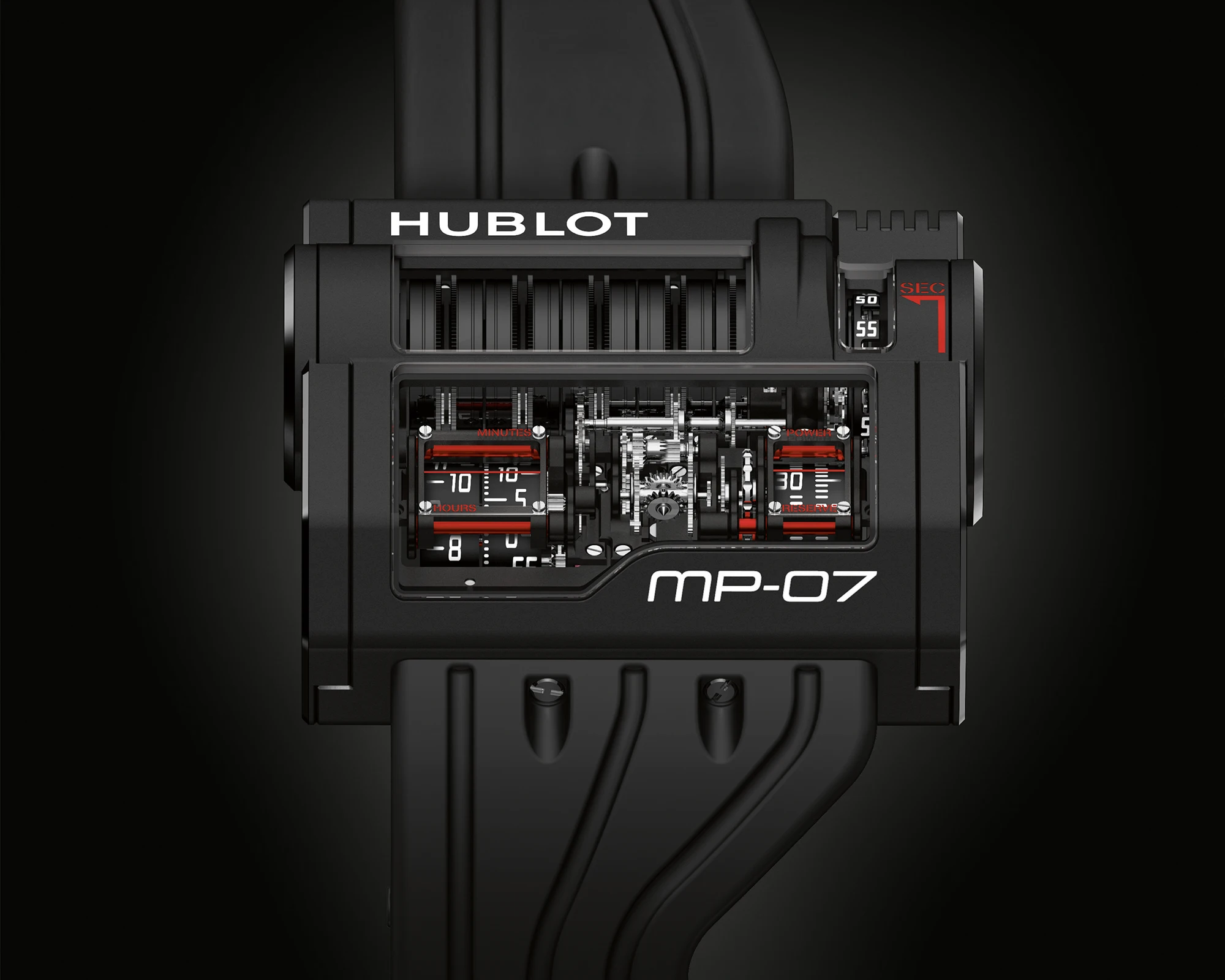
42 Days, or 1,008 Hours of Power Reserve
Like the MP-05 La Ferrari, the MP-07 was also rooted in motorsports. This time, however, the sandblasted and polished titanium case resembled an engine block rather than a motor. This change in form inevitably meant that the barrels were no longer vertically aligned, and the horizontal shape of the new case could only house 9 instead of 11 barrels. Consequently, the MP-07’s power reserve was reduced by 8 days to 42 days compared to the MP-05, but it significantly improved the time display. Despite its visually striking design, the MP-07 made reading the time easier. One simply follows the rotating cylinders, reminiscent of an odometer, to read the hours, minutes, seconds, and power reserve. However, this unusual design also meant that the watch was unusually tall, with a case height of 24 mm, making it a true statement piece that cannot be easily concealed under a shirt or suit sleeve.
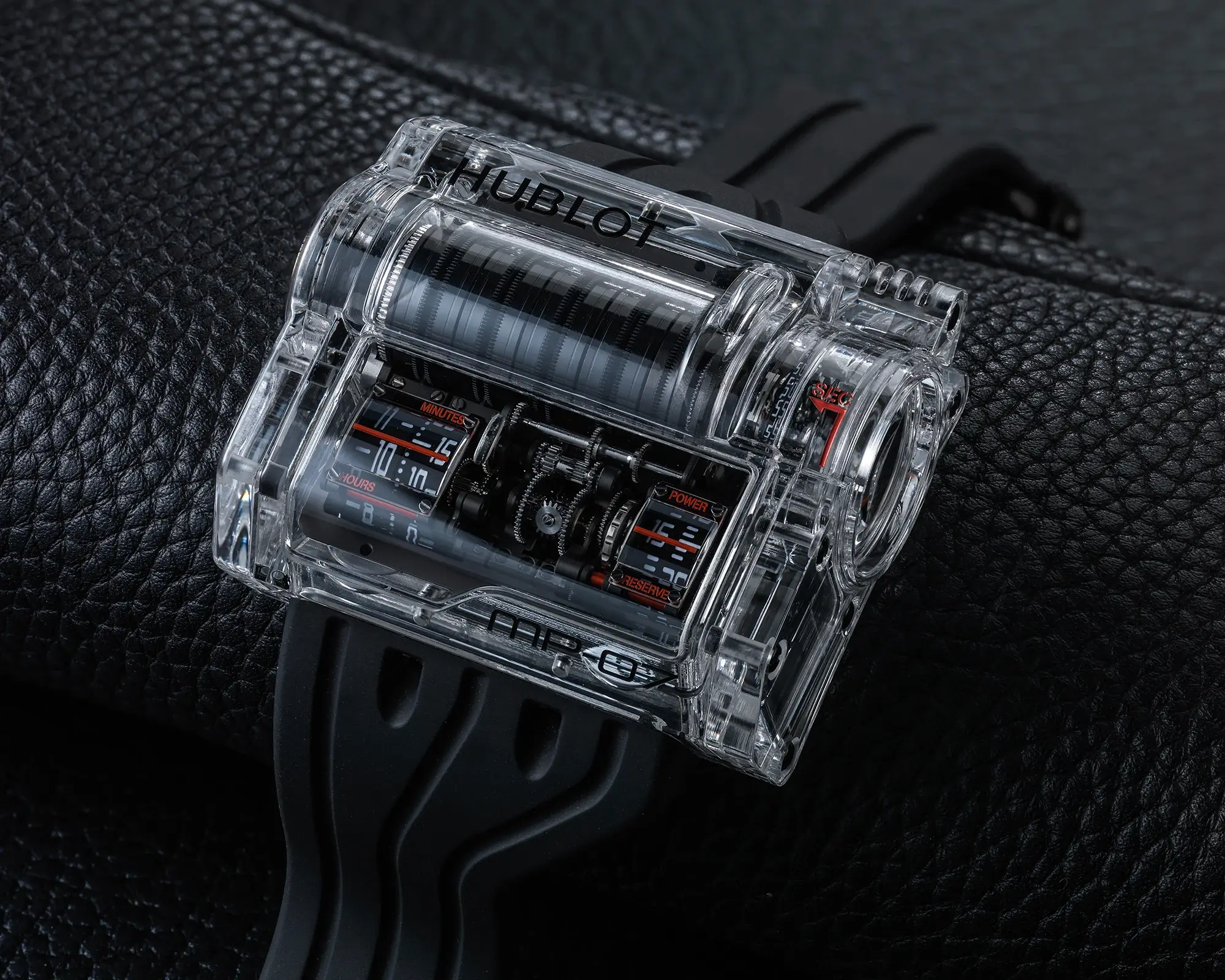
An in-house calibre
Inside the MP-07 is the in-house calibre HUB9007.H1.PN with manual winding, composed of 487 individual components, and featuring the aforementioned 9 interconnected barrels coated with black PVD, enabling a power reserve of 42 days. The crown is not found on the side of the case as usual but on the caseback. Due to the long power reserve, a special tool resembling a electric screwdriver is needed to wind the watch.
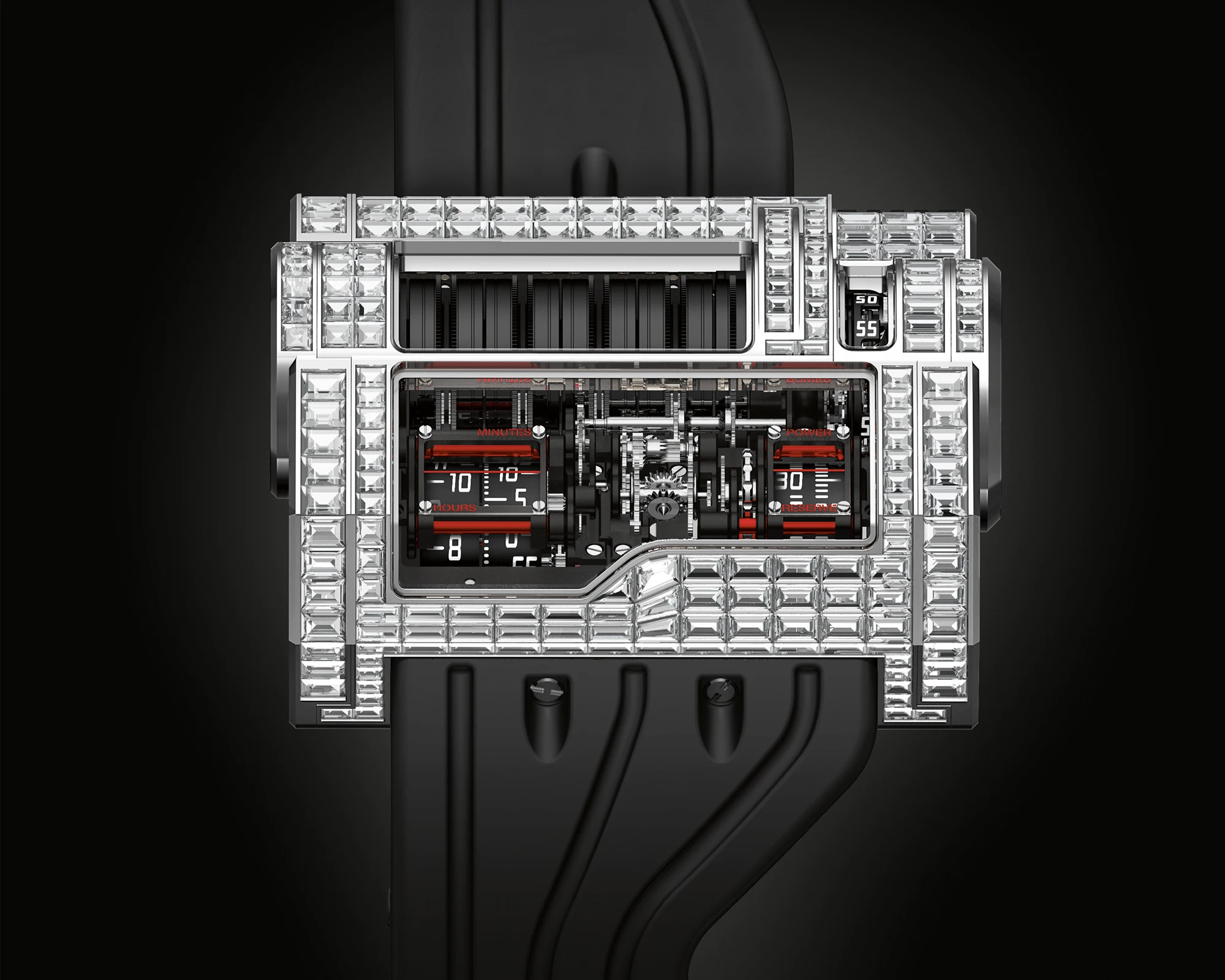
Hublot Masterpiece Collection: the MP-09 Tourbillon Bi-Axis from 2017
With the MP-09 from 2017, two innovations were introduced to the MP collection. The first innovation was the MP-09’s debut of the double-axis tourbillon within the MP collection, consisting of a small tourbillon and a large tourbillon cage that rotates around two axes. The second innovation involved the case, featuring a large opening at 6 o’clock to enhance the view of the watch’s heart.
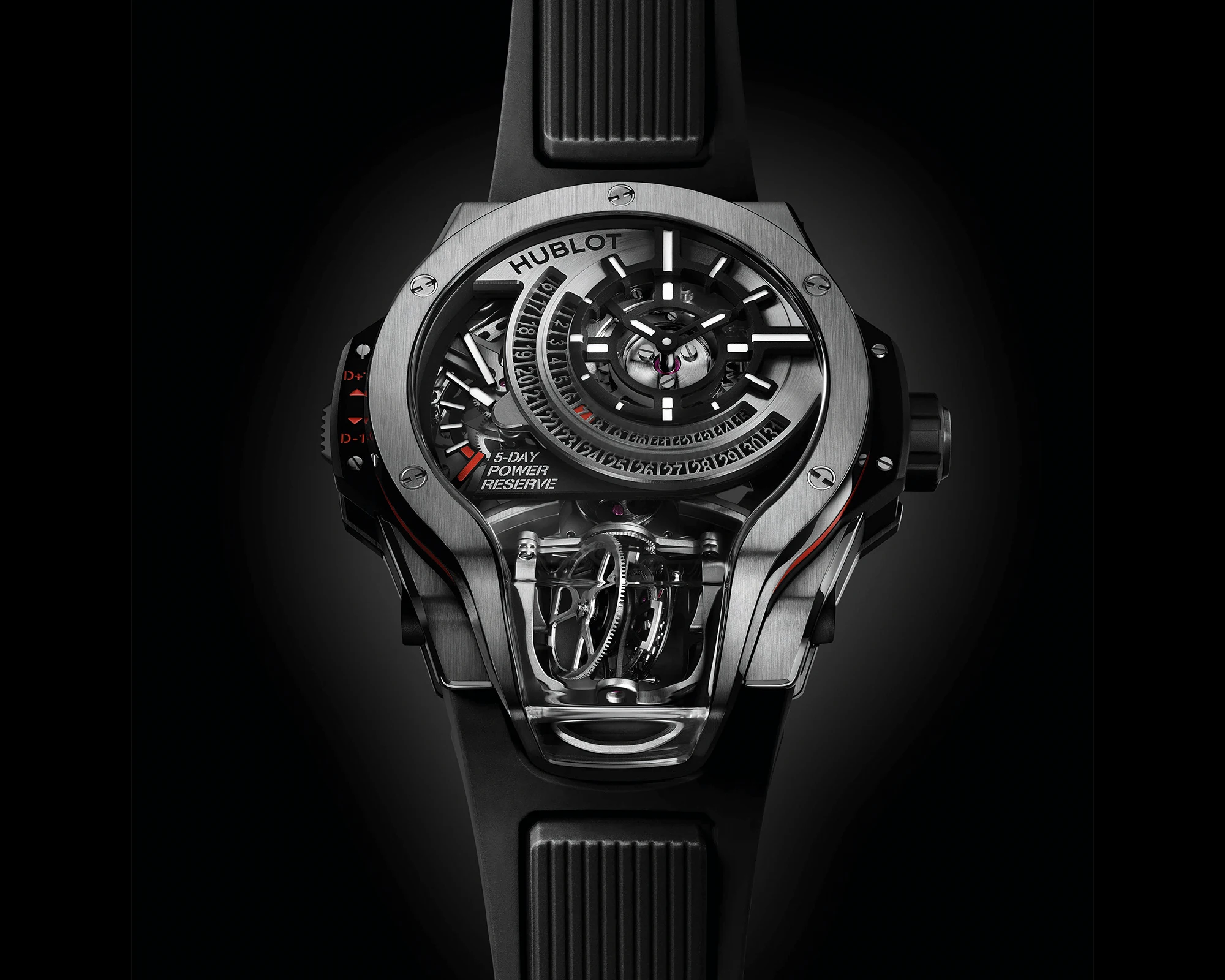
The Double-Axis Tourbillon
But first things first: the tourbillon was invented by Abraham Louis Breguet in 1795 to compensate for the positional changes of pocket watches and the resulting inaccuracies by rotating a cage. This cage contains the balance wheel (the heart of a watch responsible for timekeeping accuracy) and the entire escapement system (which ensures a uniform release of energy). Thanks to this rotation, where the tourbillon typically rotates once per minute around one axis, positional and centre-of-gravity errors caused by gravity when the pocket watch is worn in certain positions – such as in a pocket – are compensated for.
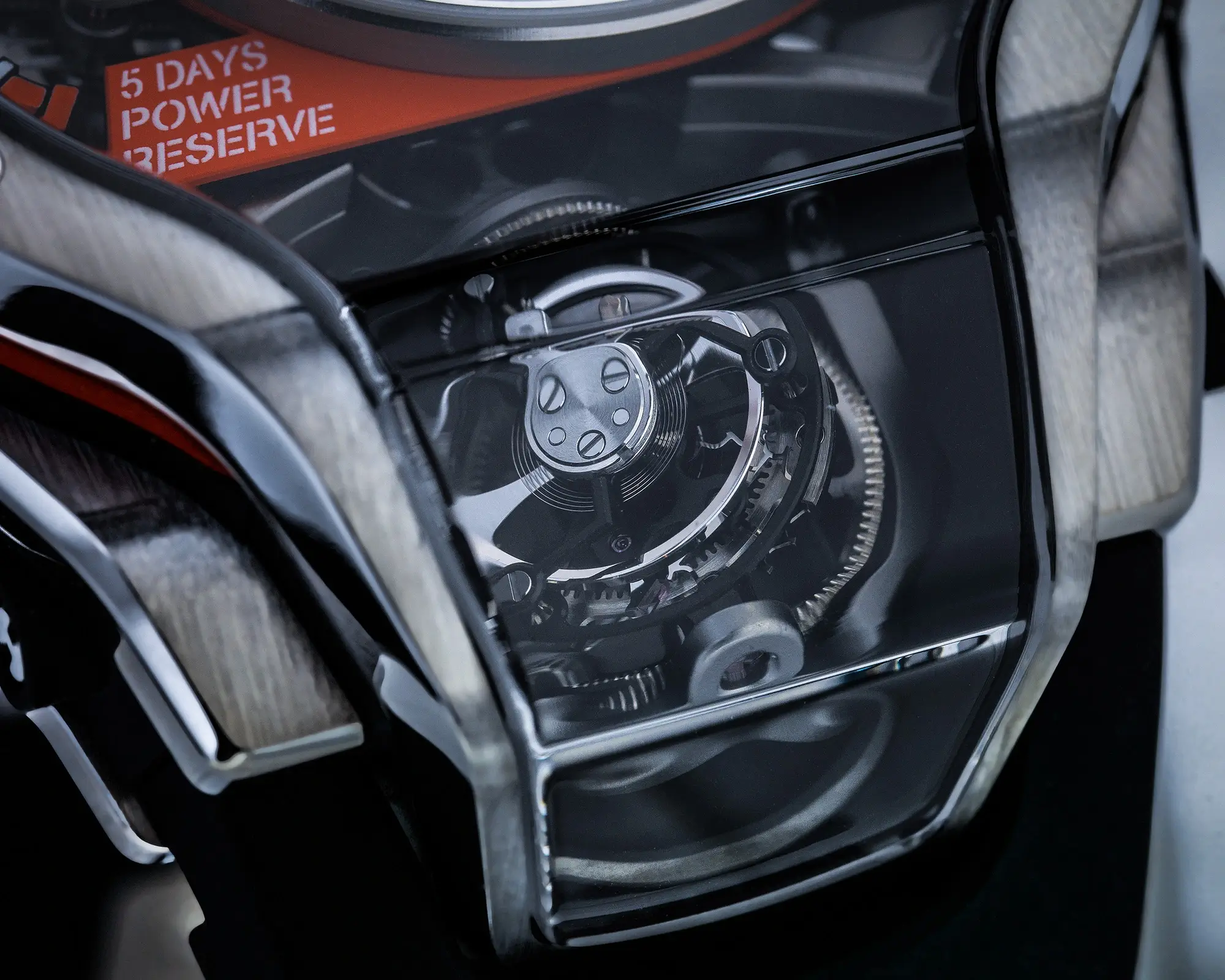
A double-axis tourbillon takes it a step further: conceived by Thomas Prescher in 2004, the tourbillon cage of this mechanism rotates not only around one axis but around two axes rotating at opposing angles. The second axis is intended to compensate for positional changes even more effectively. In the case of the MP-09, one axis completes a full rotation every minute, while the other axis rotates every 30 seconds.
The date display
In addition to this technical feature, which mainly creates an impressive visual spectacle, the MP-09 Tourbillon Bi-Axis also stands out with its innovative date correction, which is both simple and practical. By simply moving the lever on the left side of the case up or down, the date can be adjusted by one day forward or backward. Once set, the date is displayed on two half-circles arranged around the hour and minute display. Furthermore, the 5-day power reserve is indicated at a display located at the 9 o’clock position.
The case
The MP-09 case, with a diameter of 49 mm and water resistance up to 30 metres, was released in two different variations: the MP-09 made from natural titanium was limited to 50 pieces, while the rose-gold version, also known as ‘King Gold’ by Hublot, was produced in an edition of just 20 pieces.
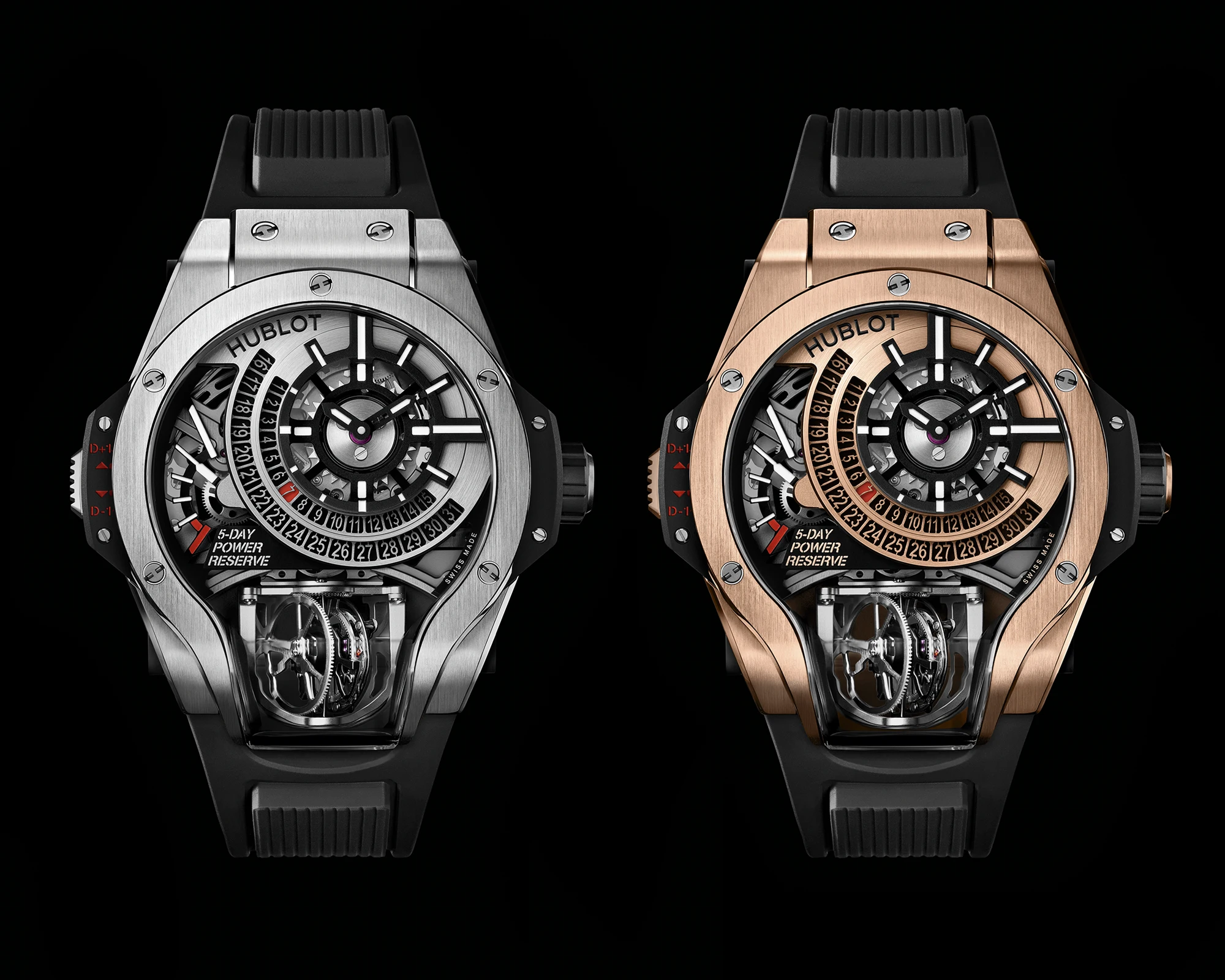
The MP-11 from 2018
In 2018, Hublot followed up with the Big Bang MP-11, available in two versions, with a sapphire crystal or 3D carbon case (reference 911.JX.0102.RW and 911.QD.0123.RX), a further development of the expertise gained from the MP-05 “La Ferrari” in 2013. Equipped with seven serially connected barrels arranged on a horizontal axis, the model offers an impressive two-week power reserve. To transmit this energy to the hours and minutes display, Hublot’s engineers chose a vertical gear train.
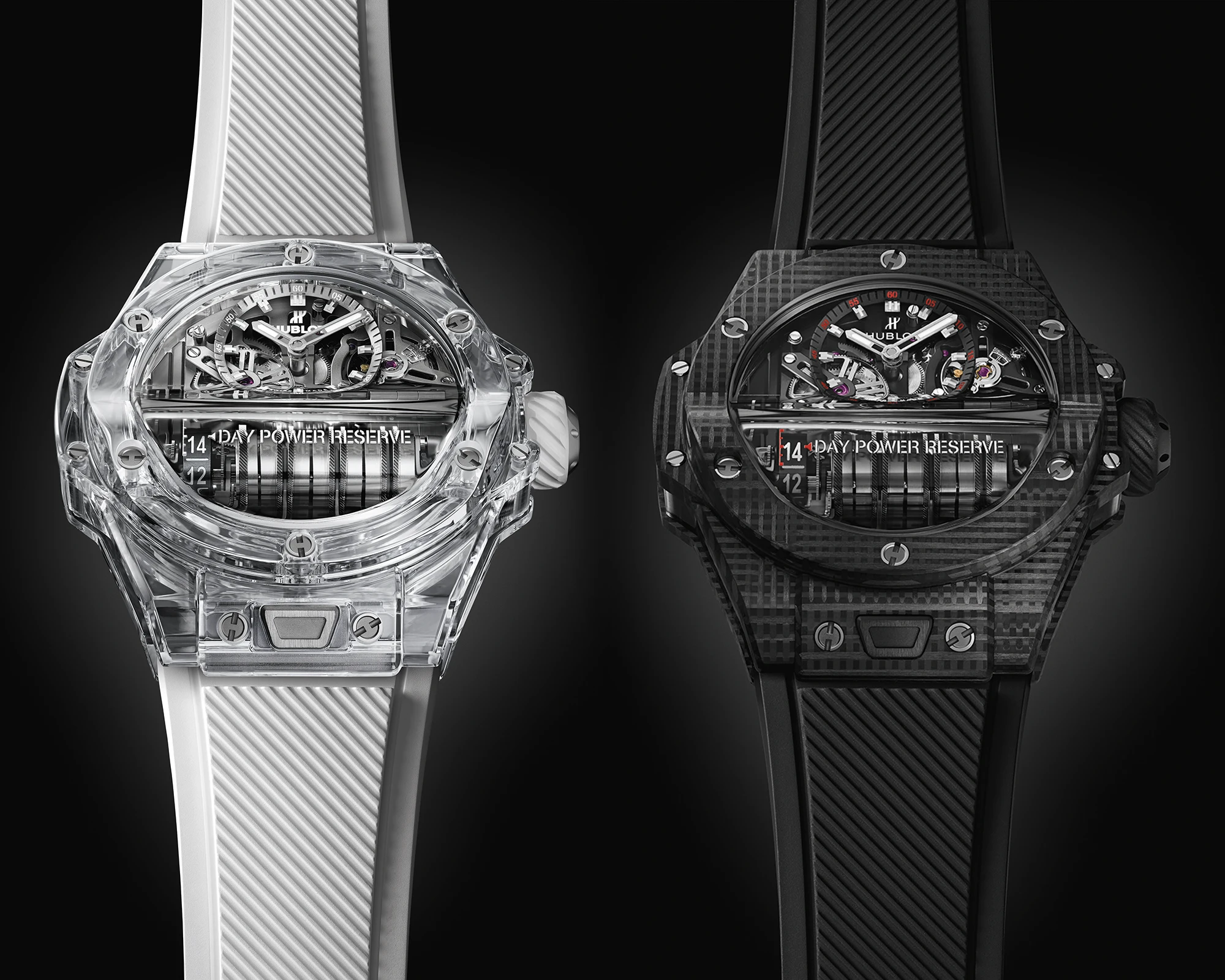
The “All Black” Big Bang was made from a polymer matrix composite reinforced with a three-dimensional weave. These properties ensure that the All Black version of the MP-11, including the strap, weighs just 90 grams.
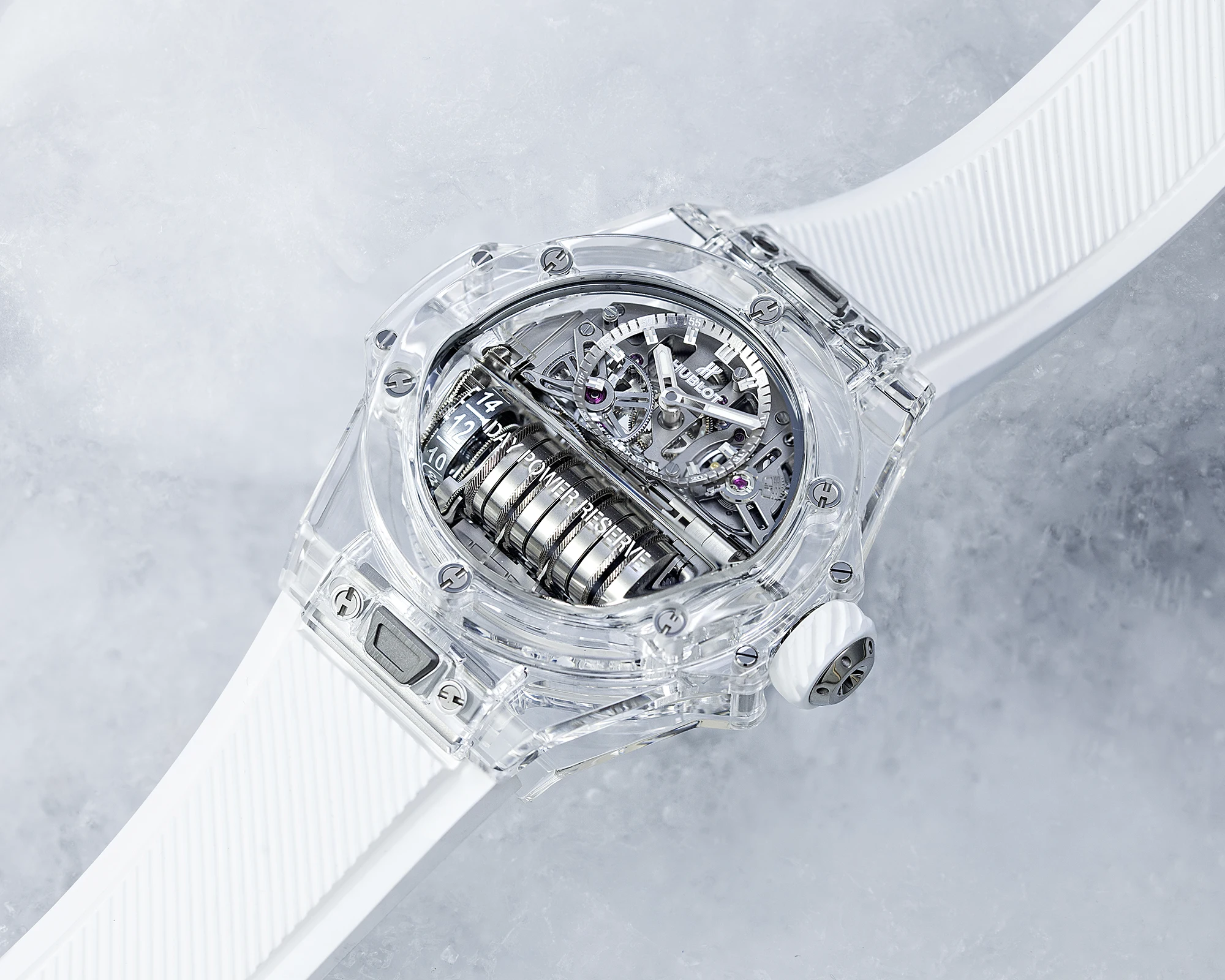
In contrast to its black counterpart, the sapphire crystal version of the Hublot Masterpiece Collection MP-11, limited to 200 pieces, emphasised the transparency of the case. Hublot describes itself as a leader in the large-scale machining of sapphire crystal, which is difficult to work with due to its hardness. To underline this claim, they machined the case of the MP-11 to follow the shape of the cylinders and curve with them.
HIGHLIGHTS 2021 – 2024
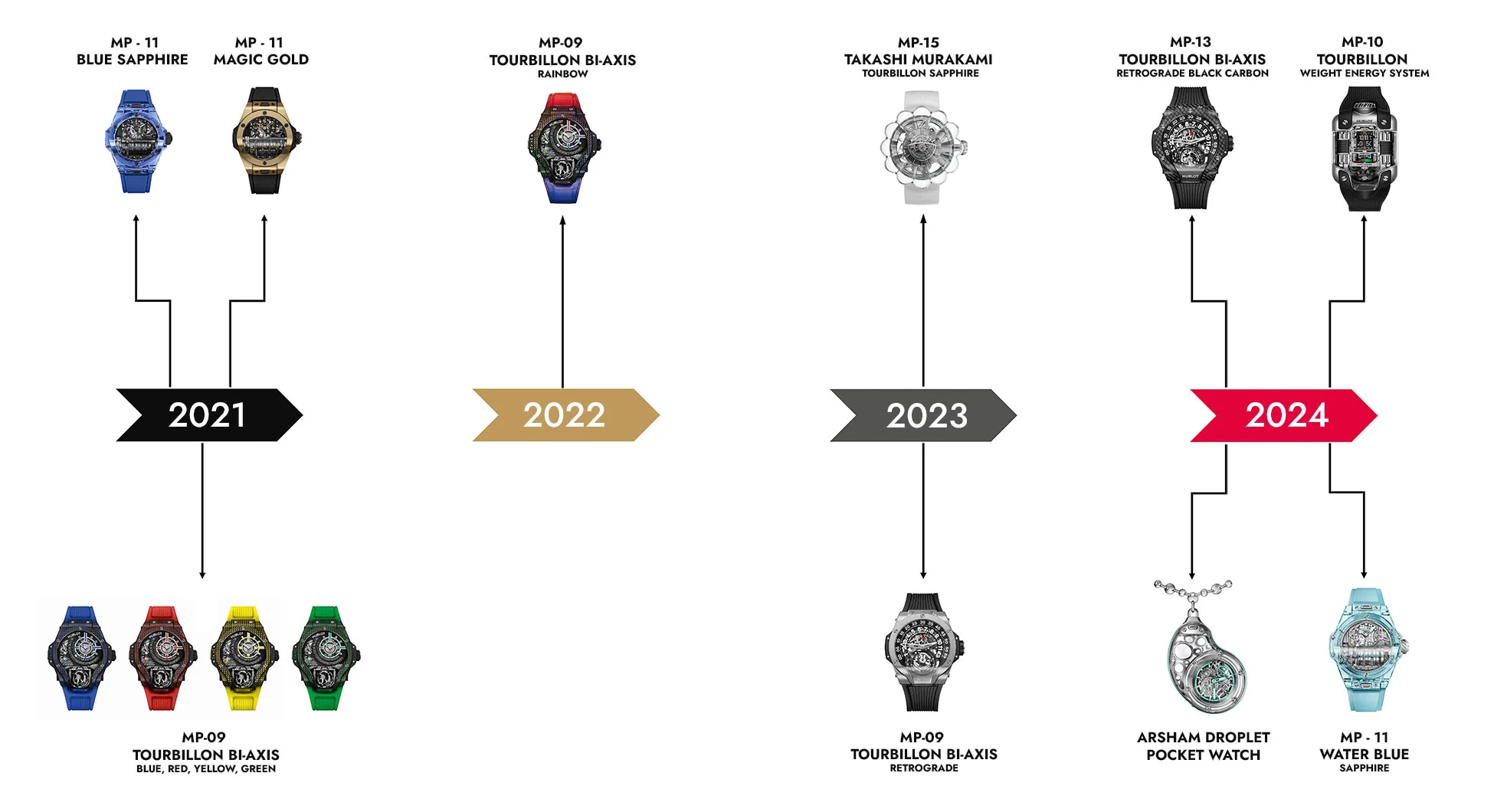
The MP-15 from 2023
“Superflat” is the name of the Japanese art movement founded by Takashi Murakami, who, together with Hublot, created the MP-15. As the name “Superflat” suggests, the art movement is characterised by the absence of perspectival depth, which is a reference to both traditional Japanese art styles, such as the Ukiyo-e style that emerged during the Edo period (1603–1868), and modern Japanese pop culture. Similar to Ukiyo-e, the Superflat movement emphasises flat representation, where space and perspective are often suggested in simple yet effective ways. Takashi Murakami became popular primarily for his ability to incorporate his style into pop culture, such as in the album cover for Kanye West’s Graduation in 2007.
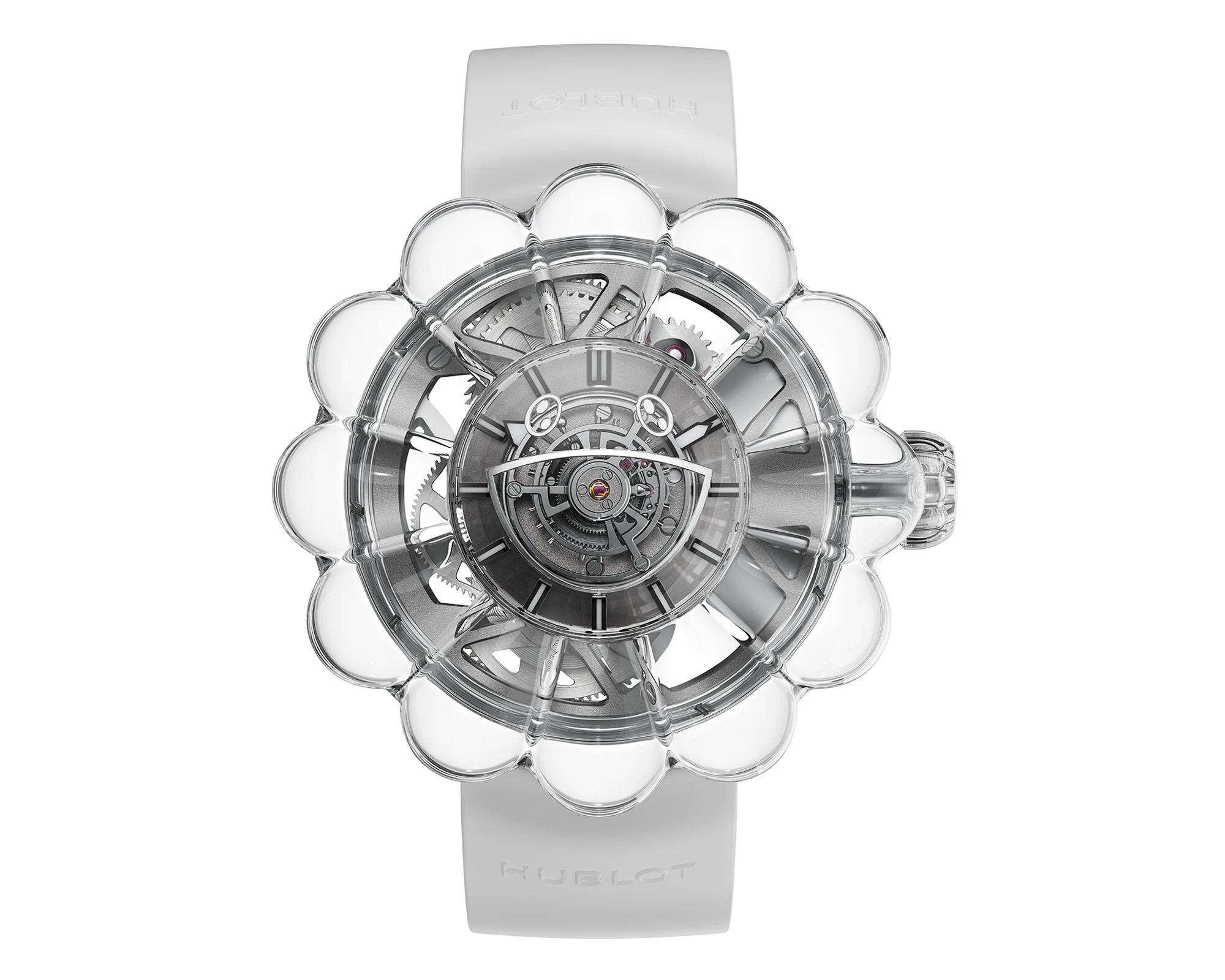
With the MP-15, on the other hand, Murakami transforms the ‘Smiling Flower’, his most emblematic motif and thus the Superflat movement, into a three-dimensional form. The motif transforms the 42 mm diameter case into a flower with 12 petals, which, together with the case back and crown, are all made of sapphire. In the centre, a flying central tourbillon and the movement mechanism breathe life into the flower. As if detached from the rest of the watch, the central tourbillon rotates, powered by two barrels with a power reserve of 150 hours, i.e. almost a whole week. In addition, two diagonally arranged hands, which point to an equally diagonal flange with twelve white indices, indicate the time. The MP-15 is limited to 50 pieces and can be purchased at a price of CHF 300,000.
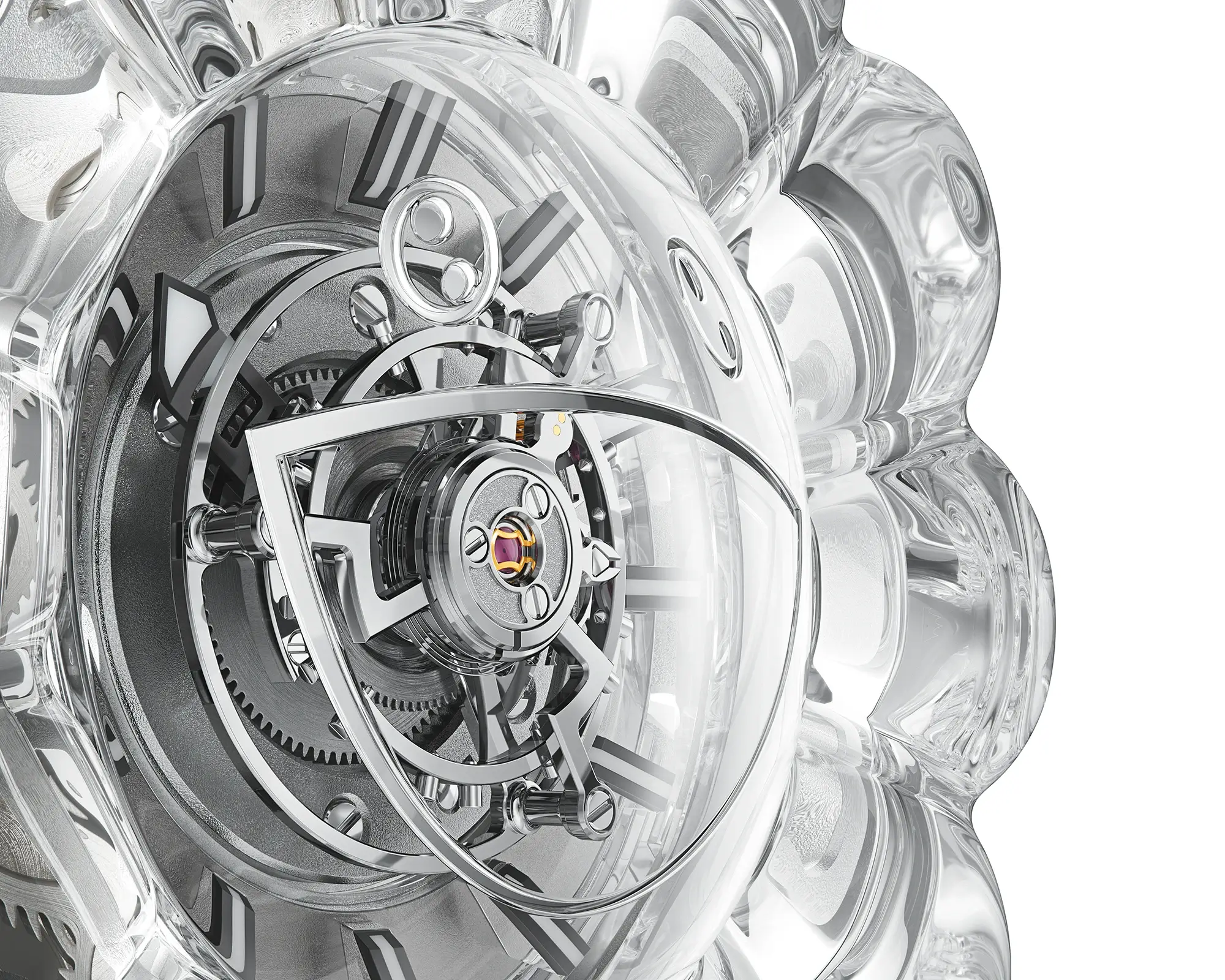
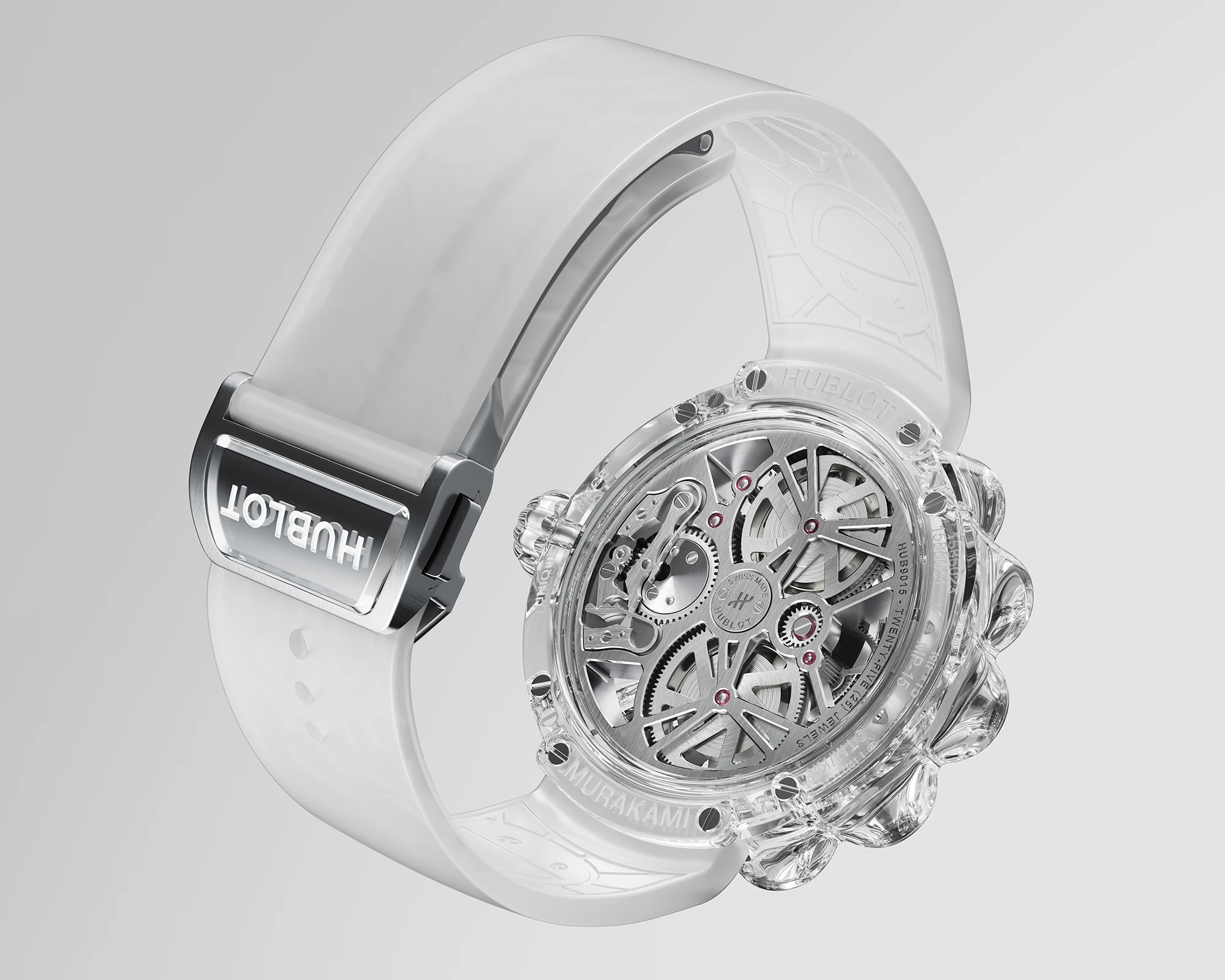
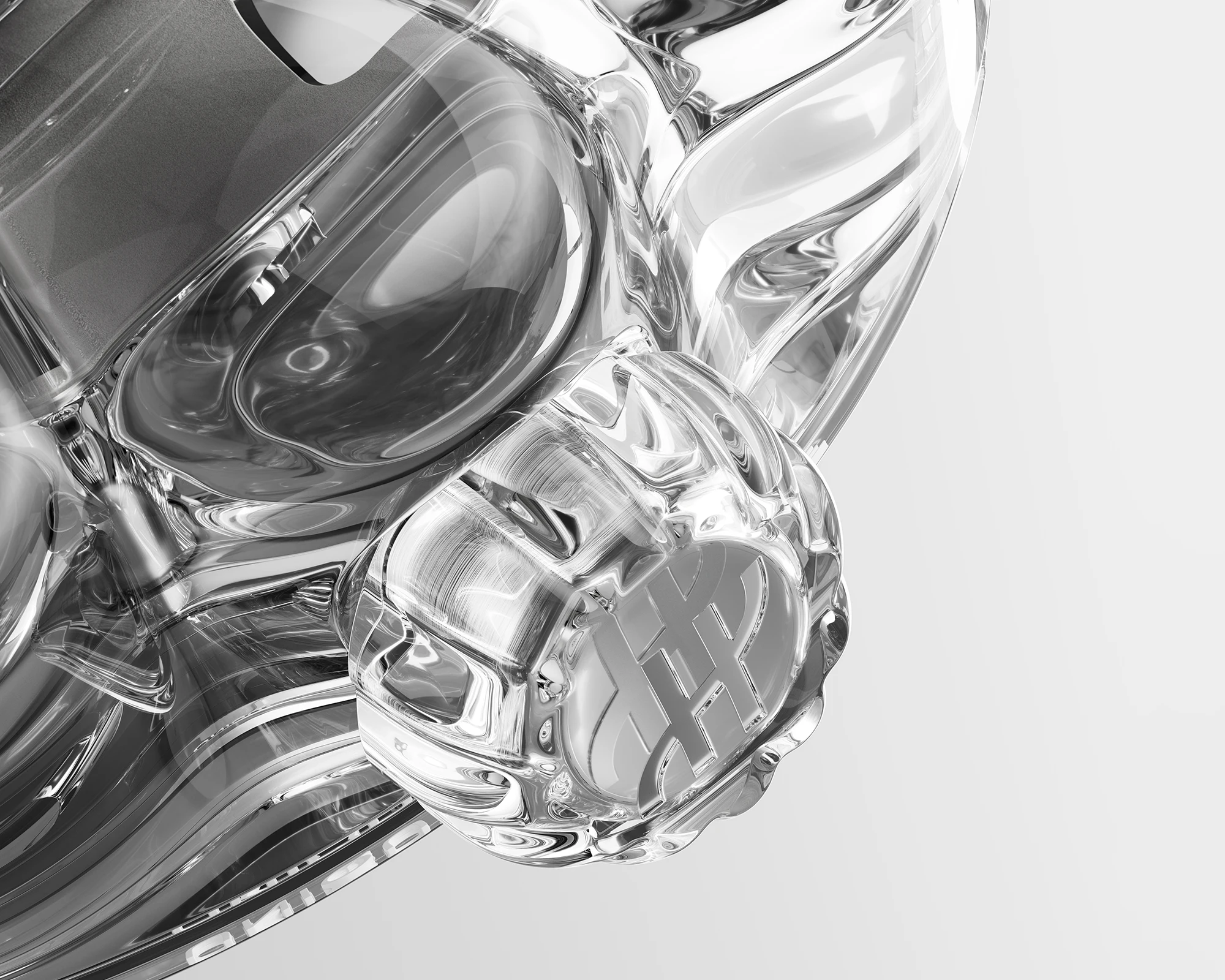
The MP-13 from 2023
The MP-13 from 2023 stood out not only because it was the first to combine a tourbillon with a retrograde display from the Hublot Masterpiece collection, but also because of its case design, which was established by the MP-09. With a flowing, asymmetrical shape of the sapphire crystal, which gives the impression that it is literally ‘dripping down’, it not only lends the watch a dynamic quality, but also provides a clear view of the highlight of the watch: the double-axis tourbillon.
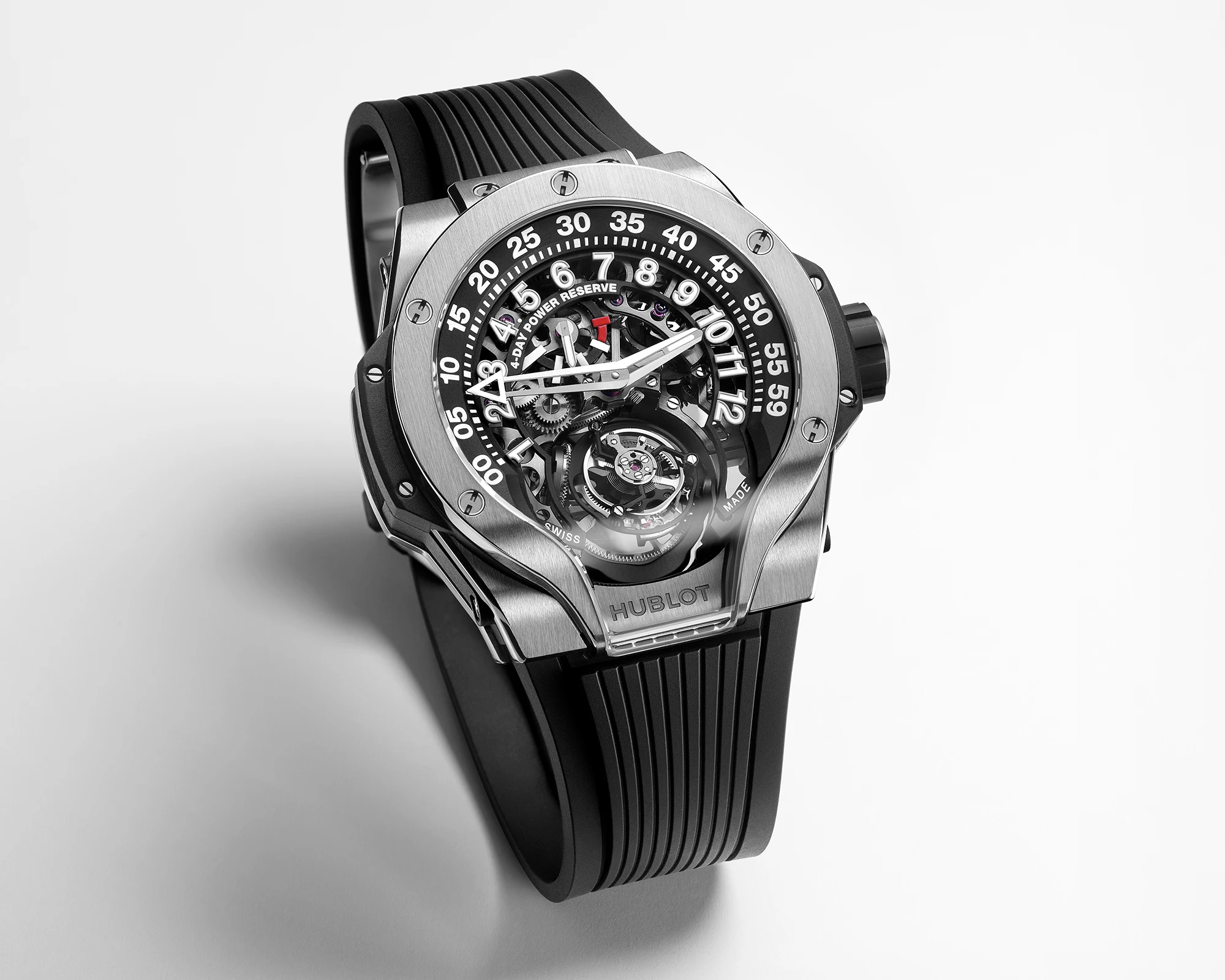
The flying double-axis tourbillon
Manufactured in-house by Hublot and first introduced in the aforementioned MP-09 from 2017, one axis of this special tourbillon construction performs a full rotation every minute, while the other axis rotates every 30 seconds. This different rotation within the same mechanism makes for a fascinating spectacle, which is complemented by the ‘flying’ construction of the device. The special feature of the flying tourbillon is that the upper bridge for supporting the cage is dispensed with and the cage is supported solely on the underside, creating a floating impression. Despite this complex device, the MP-13 has a power reserve of four days or 96 hours.
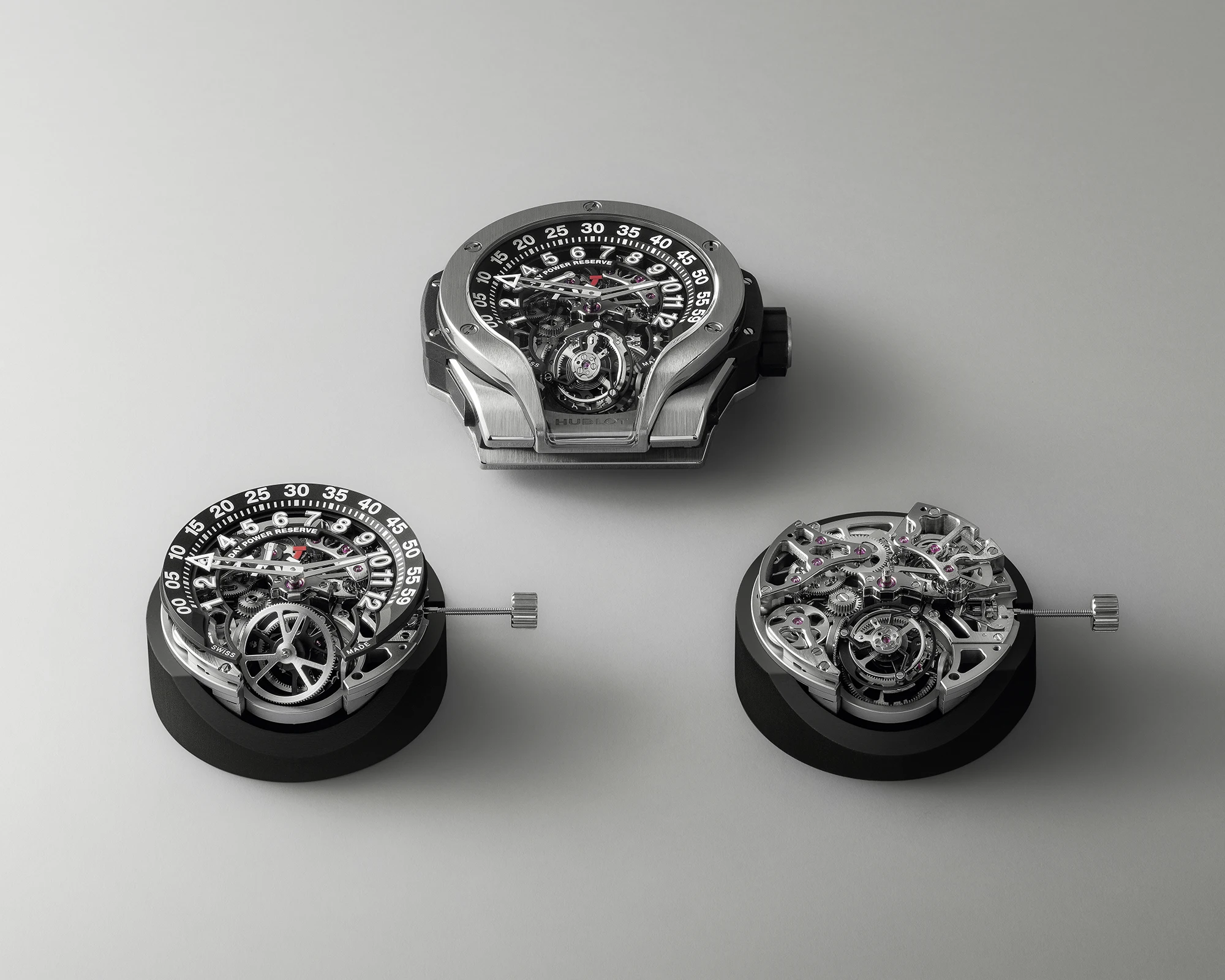
The retrograde display
Despite its seemingly complex structure, the retrograde display is intuitive to read. The minute hand starts at 00 and moves to 59 before immediately snapping back to its starting point. The same applies to the hour hand, which this time moves between 1 and 12 in the lower hour register. Interested parties will have to pay CHF 150,000 for this special timepiece with its unique case shape.
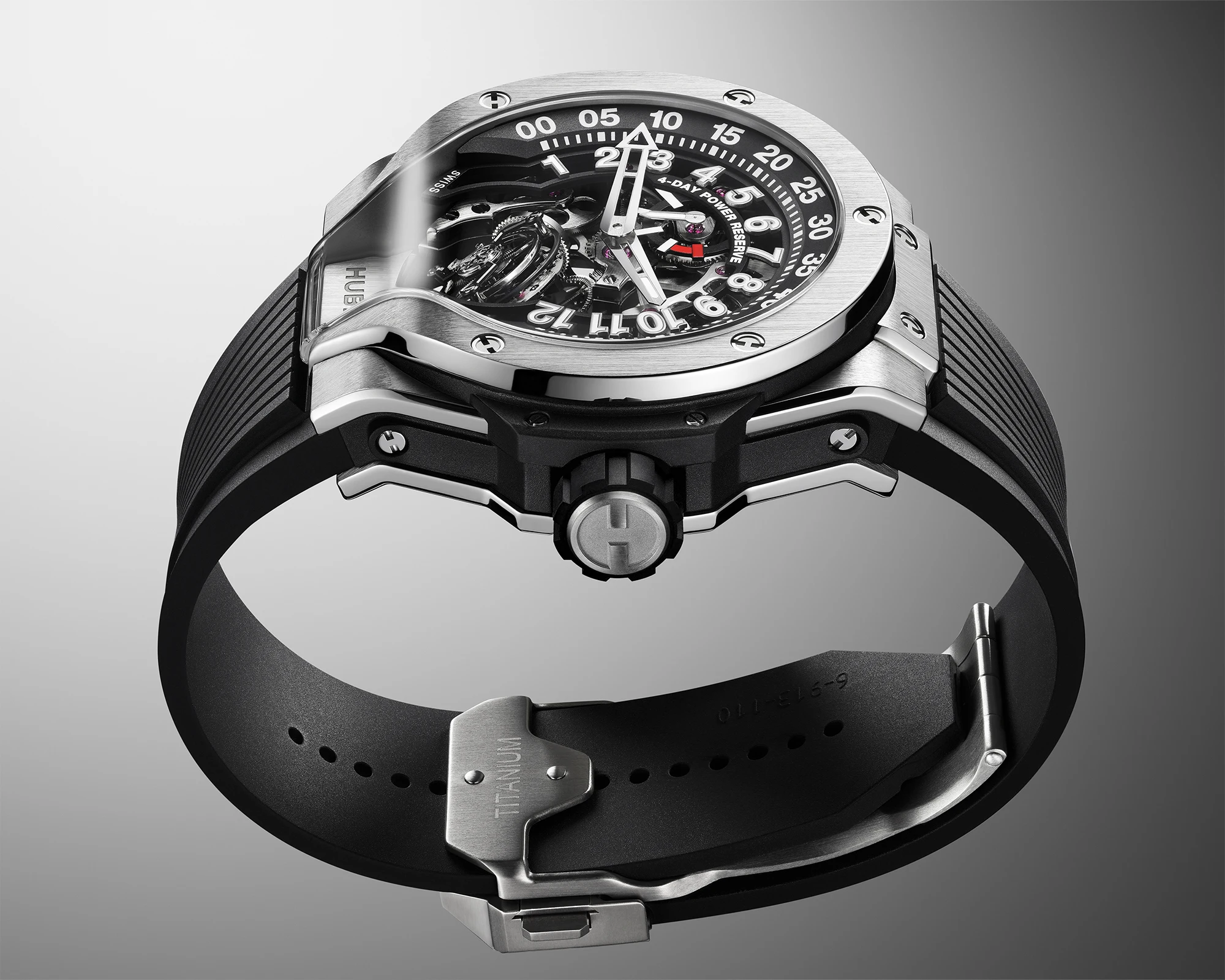
Hublot Masterpiece Collection: the MP-10 from 2024
The manufacture’s tenth masterpiece was the most forward-looking timepiece in the line to date. When it was launched, it broke away from traditional watchmaking by presenting not only an innovative approach to the time display, but also to the winding of the watch in a new design, which led to two patent applications. Not only were the hands removed, but also the entire dial, which was replaced by four constantly rotating displays.
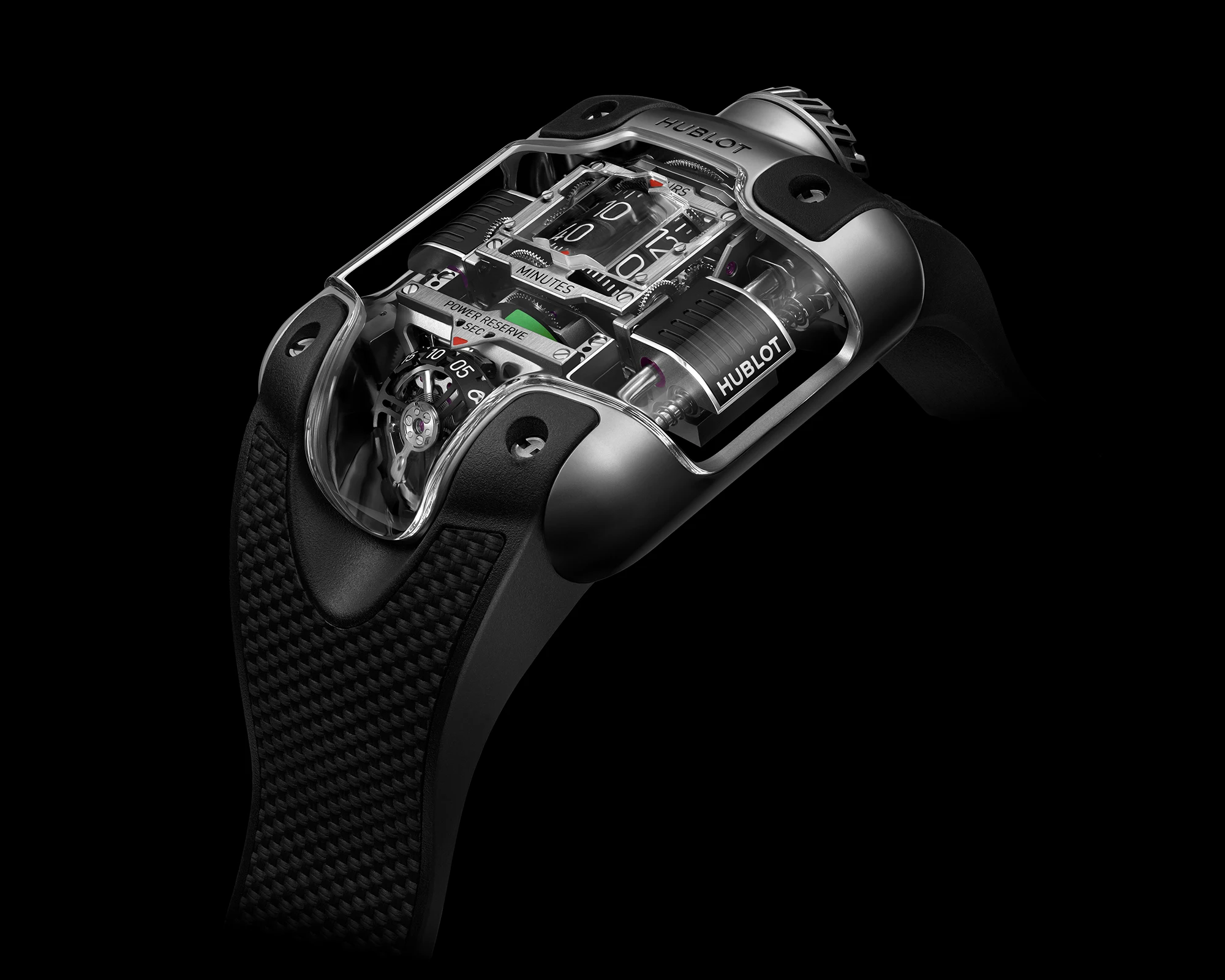
The time display
Two round displays in the upper third show the hours and minutes. Below this is the third display, which acts as a power reserve indicator using green and red areas to show how much energy is left. In the lower third, the tourbillon, which is rotated by 45 degrees, houses the seconds display, which is mounted directly on the tourbillon cage. The construction of the tourbillon is the first patent for this timepiece.
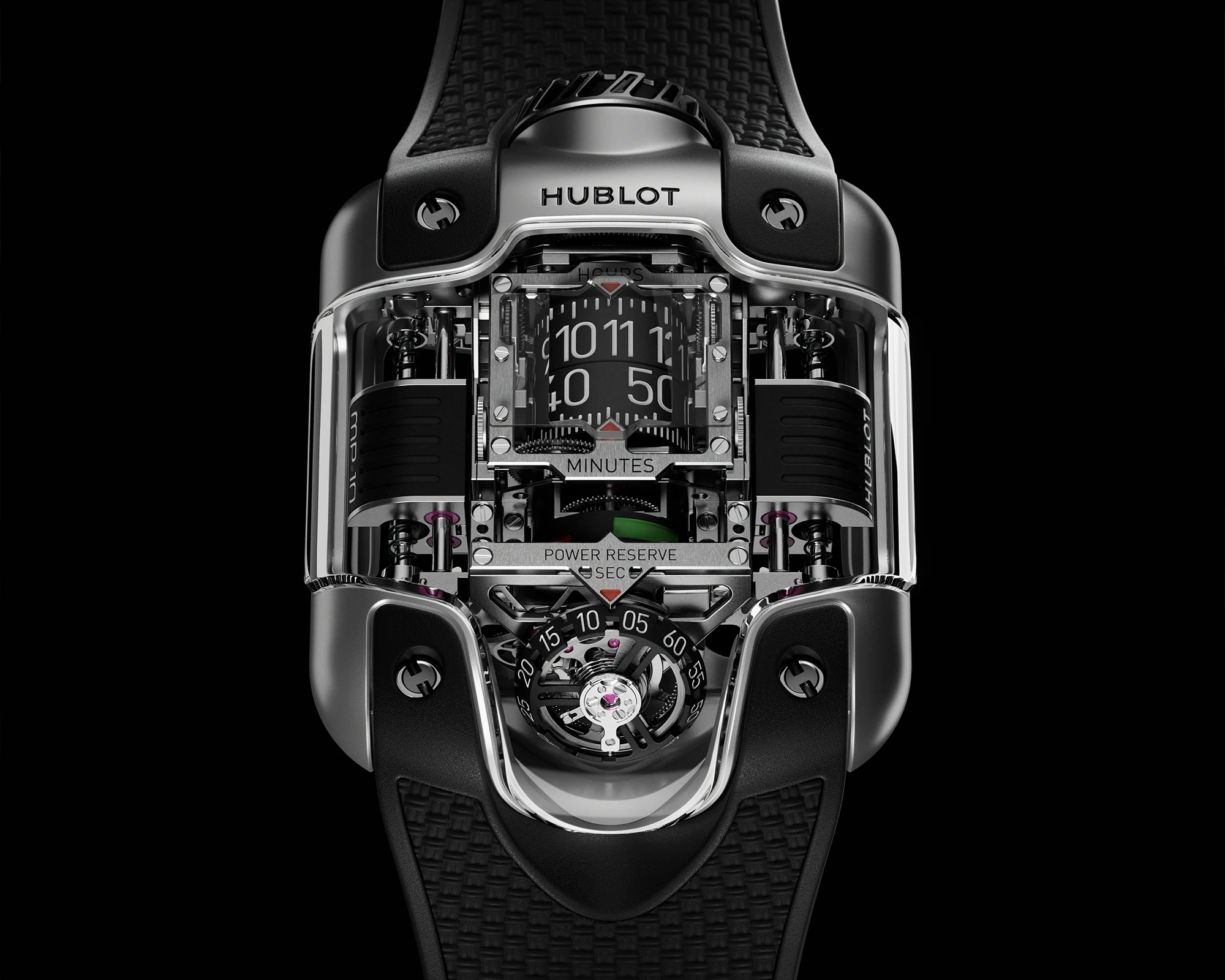
However, as already mentioned, it is not only the innovative solution of the time display, but also the construction of the automatic winding mechanism, for which Hublot applied for a patent, that gives the timepiece its futuristic appearance. Two linear weights made of white gold, located on the left and right inside of the case, take over the task of winding the watch instead of a rotor. These two vertical weights engage with a rack and wind the movement bidirectionally with the wearer’s movements, giving the watch a power reserve of more than 48 hours. Shock absorbers ensure that the blocks are gently slowed down by the movements of the wrist.
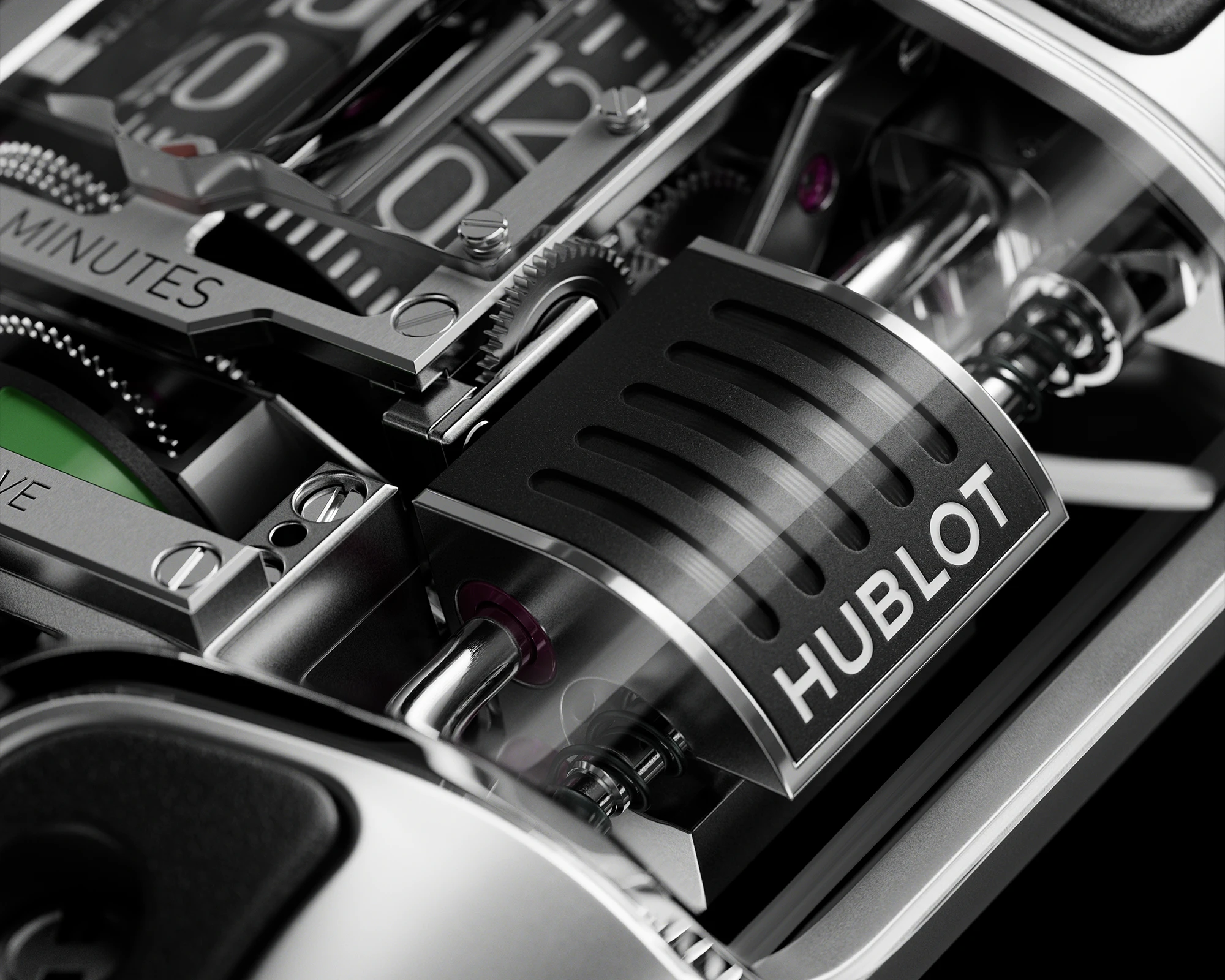
If the watch does run out of power, an oversized crown, which is integrated into the shape of the MP-10 and located at 12 o’clock, ensures that the watch can be wound manually. A second crown, set into the back of the case, allows the time to be set.
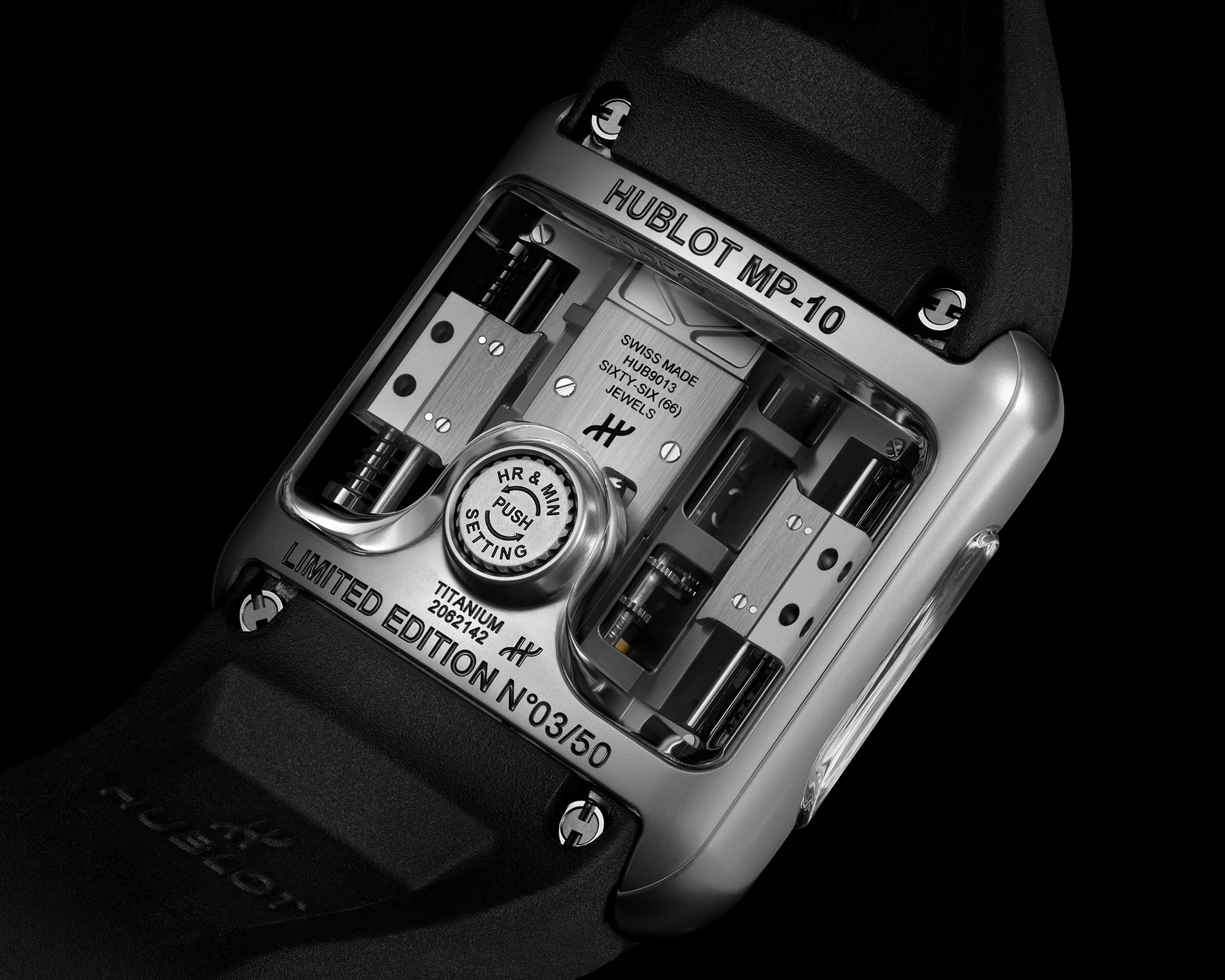
In 2025, to mark the 20th anniversary of the Big Bang, Hublot unveiled two new limited editions of the MP-10, which, while powered by the same HUB9013 movement, introduced two new case materials in addition to the original titanium version. Firstly, Hublot presents the reference 910.CX.0000.RX – an All-Black version of its MP-10 in black ceramic, limited to 50 pieces. Meanwhile, the reference 910.JX.0001.RT, limited to 30 pieces, offers complete transparency thanks to a case crafted entirely from sapphire crystal. Both versions not only share the imposing case size of 54.1 mm, but also feature a crown at the 12 o’clock position, engraved with “20 YEARS”. With a retail price of 400,000 CHF, the sapphire version is exactly 100,000 CHF more expensive than the All-Black edition.
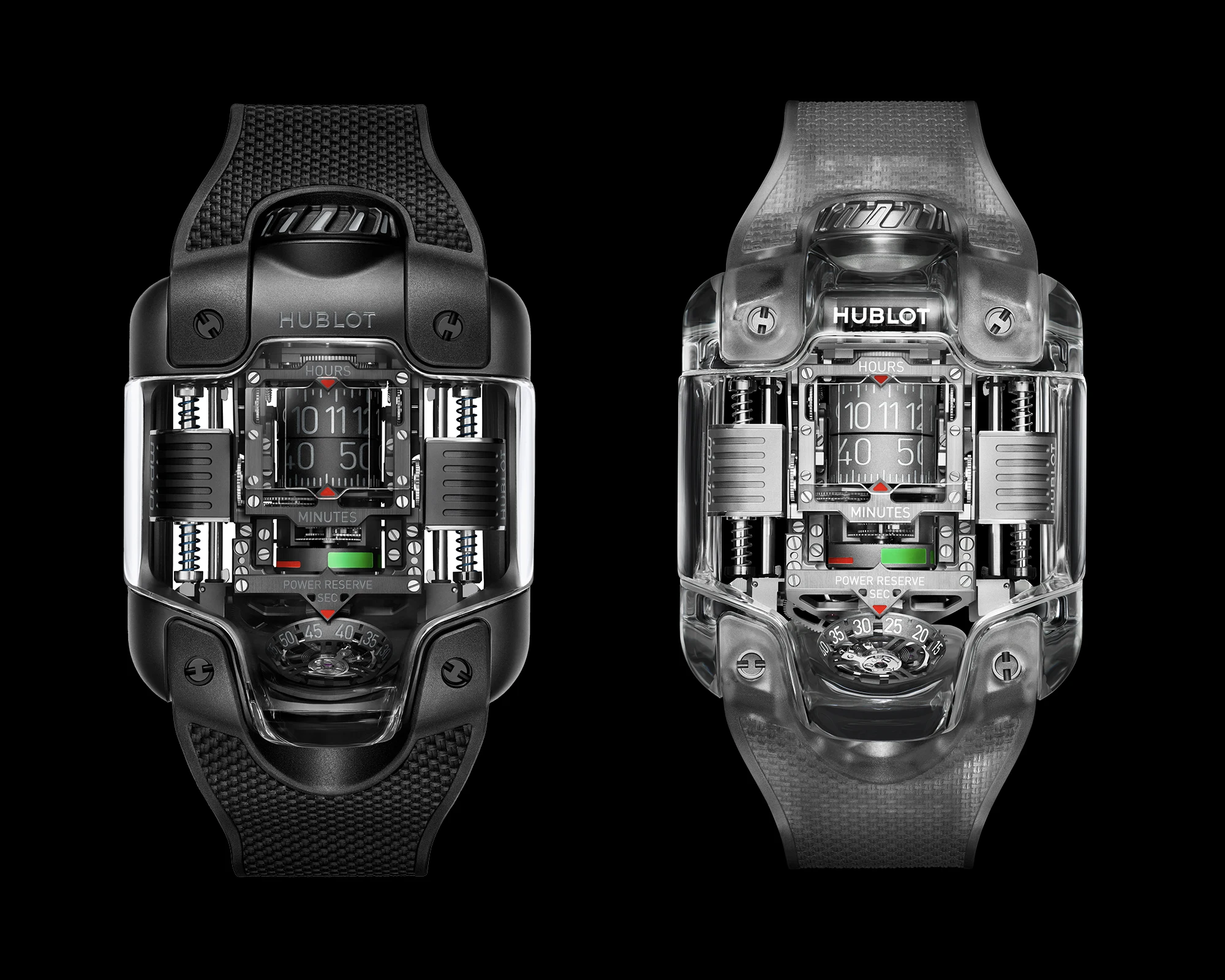
The Arsham Droplet from 2024
For the Arsham Droplet, Hublot teamed up with contemporary artist and brand ambassador Daniel Arsham to reinterpret the pocket watch. The artist, who has a sensitivity for redesigning everyday objects so that they look like ‘future relics’, has thus created a timepiece that represents a drop-shaped fusion of tradition and modernity.
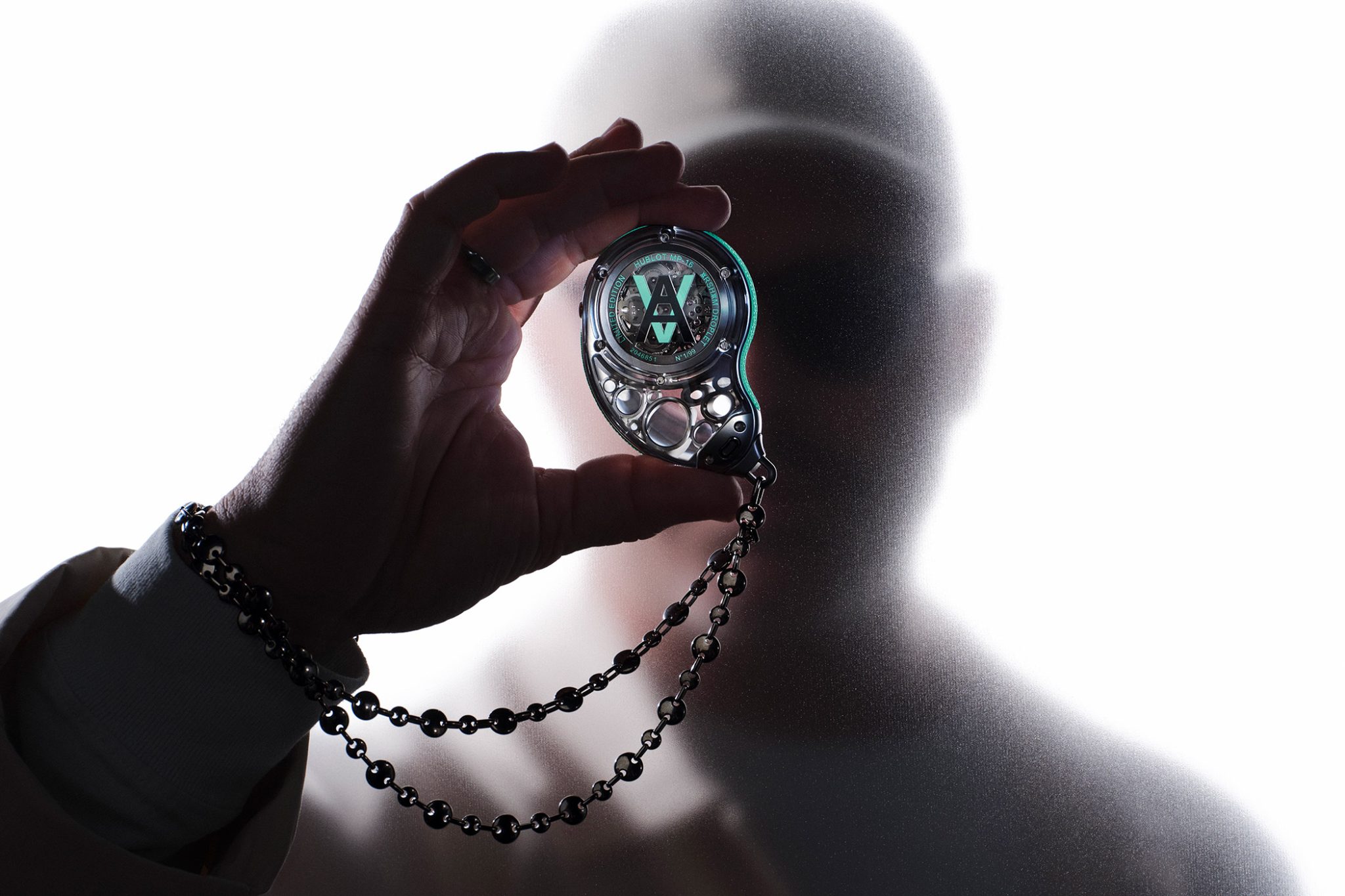
The Arsham Droplet is not just a pocket watch, but can also be worn as a pendant to become a functional piece of jewellery or transformed into a decorative eye-catcher on a table stand. As the name suggests, the titanium case of the Arsham Droplet is drop-shaped and measures 73.2 mm x 52.6 mm, while its height is 22.5 mm. To further emphasise the droplet-like aesthetic, the narrow section of the case is dotted with openwork circular shapes that are reminiscent of air bubbles in water.
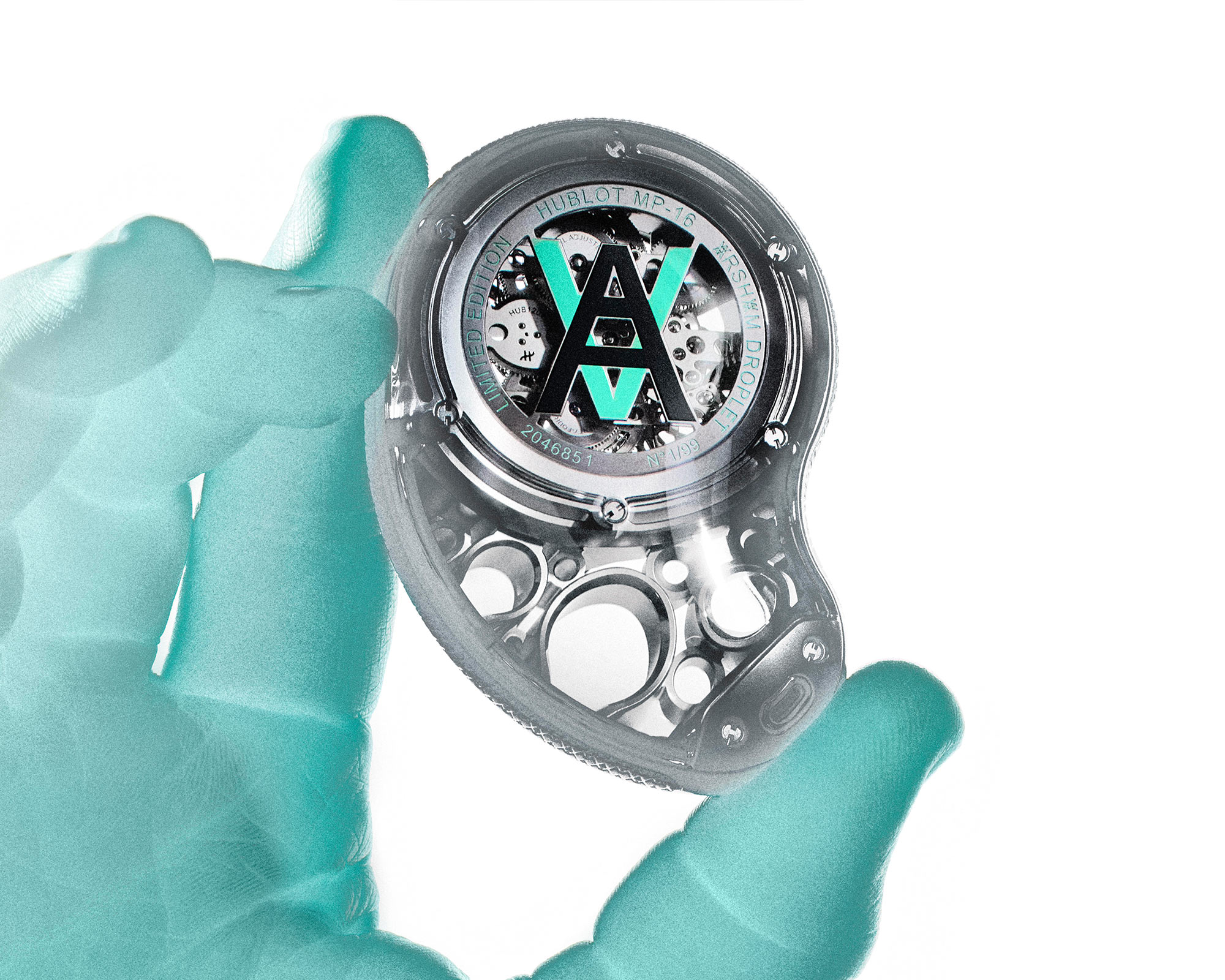
On the wider part of the pocket watch is the dial, which has a regular round shape and features a matt green index ring and matching coloured hour and minute hands. The three-dimensional Arsham monogram is located at 12 o’clock, while the Hublot logo is emblazoned underneath. Thanks to their skeletonisation, the small seconds with its quarter division in Arsham Green and the power reserve indicator in titanium with its exposed numerical disc appear to float.
Conclusion
The Hublot Masterpieces collection aims to explore and challenge the technical limits of the brand, to strengthen it and to embody its expertise through highly limited manufacture pieces that demonstrate the best of Hublot’s innovative spirit and savoir-faire. Does it fulfil this mission? In my opinion, yes, because over the years the collection has produced models, each of which offers a unique approach to time display. As a result, the collection has become both a creative workshop and a driver of innovation for the brand.

